Paul van Yperen's Blog, page 214
December 1, 2019
Georges Guétary
Suave singing star Georges Guétary (1915-1997) performed on the London and Broadway stages, but the light tenor achieved his greatest renown in France, where he had a musical career of nearly 60 years. To international cinema audiences he is best known as Gene Kelly's rival for the affections of Leslie Caron in An American in Paris (1951).
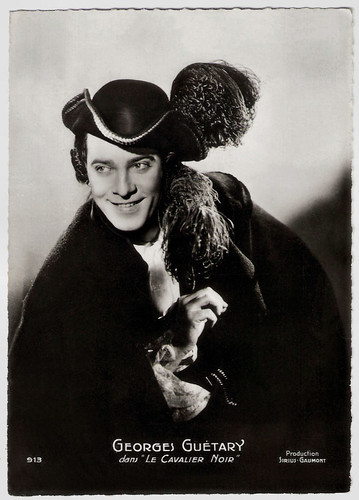
French postcard by Edition d'Art BelFrance, Paris, no. 913. Photo: Sirius / Gaumont, Paris. Georges Guétary in Le Cavalier noir/The Black Cavalier (Gilles Grangier, 1945).
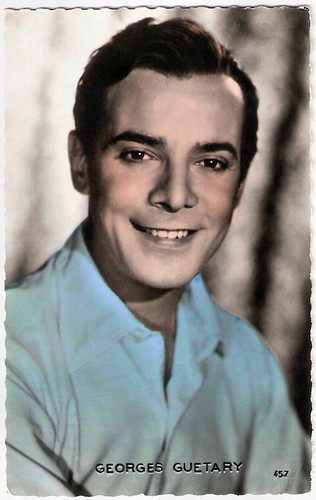
French postcard by Editions P.I., Paris, no. 457.
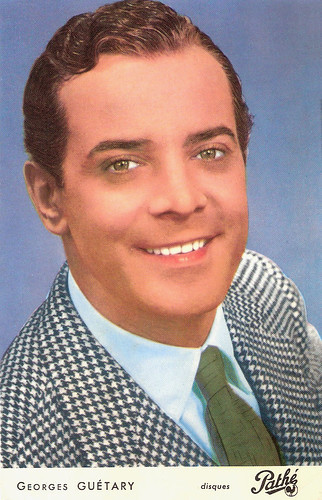
French postcard by IPB. Photo: Disques Pathé.
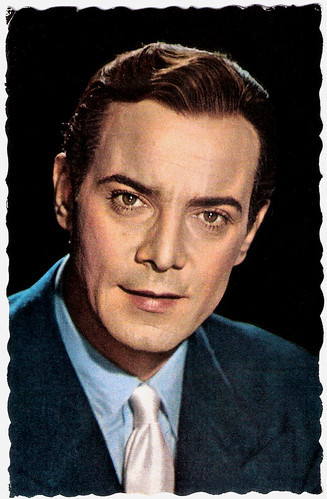
French postcard by Imp. De Marchi Frères, Marseille.
Phosphorescently Brilliant Smile and Velvety Voice
Georges Guétary was born Lambros Worloou, to Greek parents in 1915 in Alexandria, Egypt. His father was a figure in the textile industry, and intended his son to follow in his footsteps. His uncle however was the classical pianist Tasso Janopoulo, who was an accompanist to such violinists as Fritz Kreisler, Jascha Heifetz, and Yehudi Menuhin. Through his influence Lambros went to Paris in 1934, where his father hoped that he would further his knowledge of commercial procedures.
Instead Lambros studied music and voice. Humming a song in the office of a concert organiser while on an errand for his teacher, he was asked to audition, he recounted in his memoirs, and left with a one-night singing contract.
He became the singer in the orchestra of Jo Bouillon. Not long after making this first stage appearance in 1937, his career took off when he was discovered by Henri Varna, director of the Casino de Paris and became there the singing partner of the music hall queen Mistinguett .
James Kirkup at The Independent offers a different version: "he was 'discovered' one night by the eagle-eyed Mistinguett , who fell for his dimpled smile's almost phosphorescent brilliance, and for his velvety voice. He started appearing as her cavalier at the Casino de Paris in 1938, and was an immediate popular succcess."
That year he also made his first film appearance in the musical Quand le cœur chante/When the Heart Sings (Bernard Roland, 1938). In 1942 he changed his Greek name into Georges Guétary because German occupiers in wartime France were sending enemy nationals to concentration camps.
When he worked in Toulouse as a Maitre d’Hotel, he met the accordeonist Fredo Gardoni who engaged him as a singer and let him make his first record. Another important meeting was the one with Basque composer Francis Lopez in 1943. Lopez created the chansons Caballero and Robin des Bois for him, which became huge successes.
During the liberation everybody was singing his song A Honolulu (1945), also written by Lopez. That same year Georges Guétary also appeared in the film Le Cavalier noir/The Black Cavalier (Gilles Grangier, 1945) in which he again interpreted many songs by Francis Lopez: Cavalier, Avec l'amour, La plus belle, and especially Chic à Chiquito, another enormous success. His next film, Les Aventures de Casanova/Loves of Casanova (Jean Boyer, 1946), was also a smash hit.
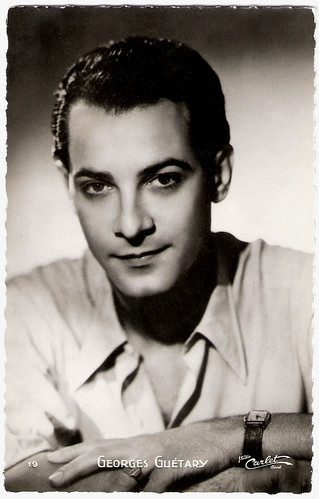
French postcard by Editions P.I., Paris, no. 19. Photo: Studio Carlet Ainé.
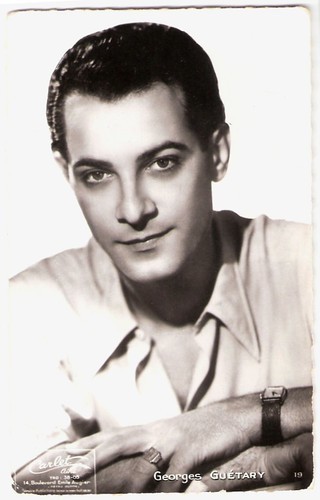
French postcard by Editions du Globe (E.D.U.G.), Paris, no. 19. Photo: Carlet Ainé.
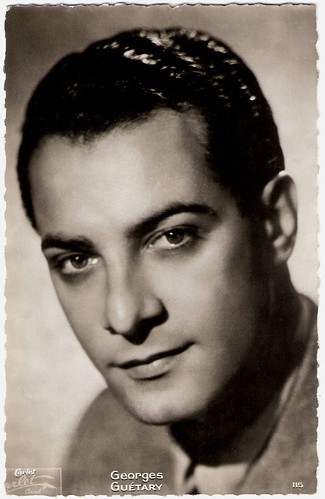
French postcard by Editions E. C., Paris, no. 115. Photo: Carlet Ainé.
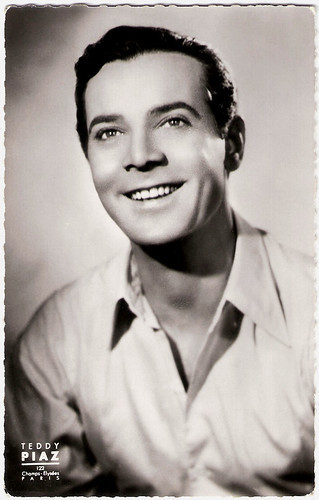
French postcard by Editions du Globe, Paris, no. 215. Photo: Teddy Piaz, Paris.
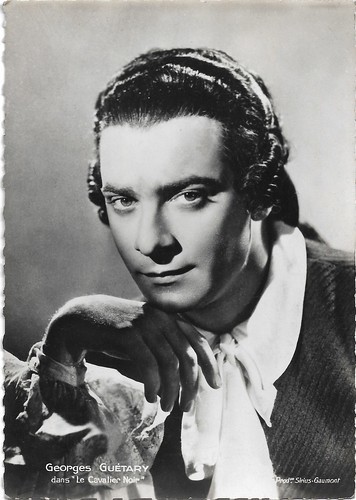
French postcard by Edition d'Art BelFrance, Paris (EAP), no. 912. Photo: Sirius / Gaumont, Paris. Georges Guétary in Le Cavalier noir/The Black Cavalier (Gilles Grangier, 1945).
From the West End to Broadway
In 1947 Georges Guétary achieved acclaim on the London stage, when he was imported from Paris by the impresario C. B. Cochran to star with Lizbeth Webb in the operetta Bless the Bride at the Adelphi Theater.
He played the role of a handsome French actor who elopes with a young English girl on the day she is to marry someone else. The bride is parted from her husband by the Franco-Prussian War of 1870-1871 and believes him killed, but the lovers are reunited in time for the final curtain.
Praise for his performance led to offers from Broadway. In 1950, he made his debut at the 46th Street Theater, starring with Nanette Fabray in Arms and the Girl, a musical set in the days of the American Revolution.
Critic Brooks Atkinson wrote in The New York Times : “The part of her foreign-born suitor is played by Georges Guetary, who can act a character and sing a song with gusto, and make stage love in the Continental style, which has obvious advantages.”
This success paved the road to Hollywood, where he appeared in his best known film, An American in Paris (Vincente Minnelli, 1951), built around the music of George Gershwin. He played Gene Kelly's rival for the affections of Leslie Caron . Guétary was the focus of attention in a spectacular scene in which he strutted up and down a majestic staircase singing I'll Build a Stairway to Paradise while flanked by willowy and scantily (but flamboyantly) clad showgirls; and he shared the spotlight with Gene Kelly in a rousing rendition of ‘S Wonderful.
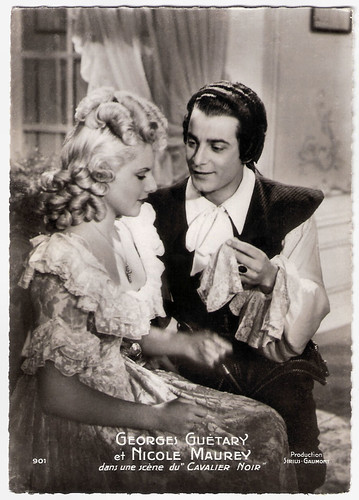
French postcard by Edition d'Art BelFrance, Paris, no. 901. Photo: Sirius / Gaumont, Paris. Georges Guétary and Nicole Maurey in Le Cavalier noir/The Black Cavalier (Gilles Grangier, 1945).
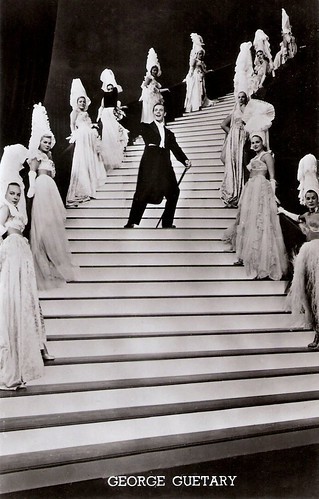
French postcard. Georges Guétary in An American in Paris (1951).
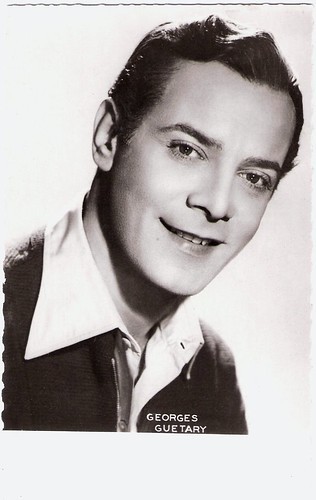
French postcard by Edition P.I., Paris, no. 29 K. Photo: Sam Lévin.
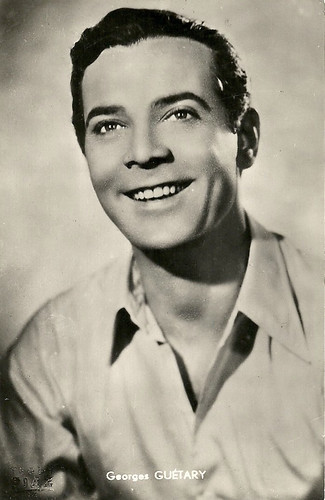
French postcard. Photo: Teddy Piaz.
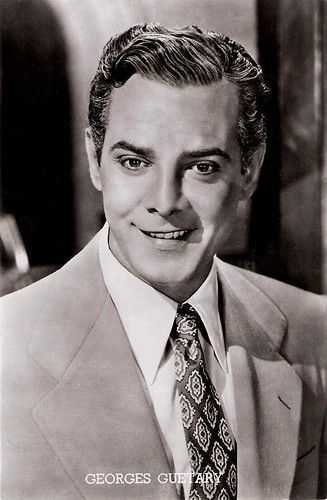
French postcard, no. 157.
Latin lover with a voice of Creme Chantilly
In 1950 Georges Guétary returned to France and became a French citizen. In 1955, he married Jeanine Guyon, then the only female producer in French television.
He starred in two enormously successful operettas by Francis Lopez, Pour Don Carlos (420 performances at the Théâtre du Châtelet, the temple of operetta) and La Route fleurie/The Flowery Path (four years at the ABC theatre) with comedian Bourvil and Annie Cordy .
Guétary starred in several more stage operettas, including Pacifico (1958), La Polka des lampions (1962), and Monsieur Carnaval (1965), with music by Charles Aznavour .
In 1981, Francis Lopez again asked Georges Guétary for a new operetta, Aventure à Monte-Carlo, which had a honourable succes. After this the two created more operettas like L'Amour à Tahiti (1983), Carnaval aux Caraïbes (1985) and Le Roi du Pacifique (1986), but they couldn’t repeat their successes of the 1950s.
Among Guétary’s most popular recordings were Bambino, Papa Aime Maman and La Samba Bresilienne. He appeared in French, Spanish and German films, including Pluma al viento/Plume au vent/Feather in the Wind (Louis Cuny, Ramon Torrado, 1952), and Le Baron Tzigane/The Gypsy Baron (Arthur Maria Rabenalt, 1954) - an adaptation of the Johann Strauss operetta Der Zigeunerbaron.
Le chemin du paradis/The Road To Paradise (Hans Wolff, Willi Forst, 1955) with Christine Carrère was an alternate language version of Die Drei von der Tankstelle/The Three of the gas Station (Hans Wolff, 1955).The two versions were a remake of the 1930 hit musical starring Lilian Harvey and Willy Fritsch .
Guétary also sang and danced on television. 'The Eternal Young Man' continued to give some 40 gala performances a year until his retirement on the Riviera in 1995.
Georges Guétary died of a heart attack in 1997 in Mougins at the French Riviera. He was 82, and was survived by his wife and two children, director Hélène Guétary and actor François Guétary.
In his obituary in The Independent , James Kirkup comes far while trying to capture Guétary's enduring appeal: "Part of Guetary's exotic charm, and much of his stage persona as a 'Latin lover' with a voice of Creme Chantilly resided in his mischievous innocence combined with an erotic mystery inherent in his ancestry. (...) The warm good-natured Guetary's teasing was always tender, and la Miss ( Mistinguett ) adored him, as did many of the ladies (and some of the gentlemen) who fell under his irresistible spell."
Theatrical trailer An American In Paris (1951). Source: Astor Theatre (YouTube).
Georges Guétary sings Les enfants du Pirée. Source: Avec Joie (YouTube).
Sources: Lawrence van Gelder (The New York Times), James Kirkup (The Independent), Wikipedia and .

French postcard by Edition d'Art BelFrance, Paris, no. 913. Photo: Sirius / Gaumont, Paris. Georges Guétary in Le Cavalier noir/The Black Cavalier (Gilles Grangier, 1945).

French postcard by Editions P.I., Paris, no. 457.

French postcard by IPB. Photo: Disques Pathé.

French postcard by Imp. De Marchi Frères, Marseille.
Phosphorescently Brilliant Smile and Velvety Voice
Georges Guétary was born Lambros Worloou, to Greek parents in 1915 in Alexandria, Egypt. His father was a figure in the textile industry, and intended his son to follow in his footsteps. His uncle however was the classical pianist Tasso Janopoulo, who was an accompanist to such violinists as Fritz Kreisler, Jascha Heifetz, and Yehudi Menuhin. Through his influence Lambros went to Paris in 1934, where his father hoped that he would further his knowledge of commercial procedures.
Instead Lambros studied music and voice. Humming a song in the office of a concert organiser while on an errand for his teacher, he was asked to audition, he recounted in his memoirs, and left with a one-night singing contract.
He became the singer in the orchestra of Jo Bouillon. Not long after making this first stage appearance in 1937, his career took off when he was discovered by Henri Varna, director of the Casino de Paris and became there the singing partner of the music hall queen Mistinguett .
James Kirkup at The Independent offers a different version: "he was 'discovered' one night by the eagle-eyed Mistinguett , who fell for his dimpled smile's almost phosphorescent brilliance, and for his velvety voice. He started appearing as her cavalier at the Casino de Paris in 1938, and was an immediate popular succcess."
That year he also made his first film appearance in the musical Quand le cœur chante/When the Heart Sings (Bernard Roland, 1938). In 1942 he changed his Greek name into Georges Guétary because German occupiers in wartime France were sending enemy nationals to concentration camps.
When he worked in Toulouse as a Maitre d’Hotel, he met the accordeonist Fredo Gardoni who engaged him as a singer and let him make his first record. Another important meeting was the one with Basque composer Francis Lopez in 1943. Lopez created the chansons Caballero and Robin des Bois for him, which became huge successes.
During the liberation everybody was singing his song A Honolulu (1945), also written by Lopez. That same year Georges Guétary also appeared in the film Le Cavalier noir/The Black Cavalier (Gilles Grangier, 1945) in which he again interpreted many songs by Francis Lopez: Cavalier, Avec l'amour, La plus belle, and especially Chic à Chiquito, another enormous success. His next film, Les Aventures de Casanova/Loves of Casanova (Jean Boyer, 1946), was also a smash hit.

French postcard by Editions P.I., Paris, no. 19. Photo: Studio Carlet Ainé.

French postcard by Editions du Globe (E.D.U.G.), Paris, no. 19. Photo: Carlet Ainé.

French postcard by Editions E. C., Paris, no. 115. Photo: Carlet Ainé.

French postcard by Editions du Globe, Paris, no. 215. Photo: Teddy Piaz, Paris.

French postcard by Edition d'Art BelFrance, Paris (EAP), no. 912. Photo: Sirius / Gaumont, Paris. Georges Guétary in Le Cavalier noir/The Black Cavalier (Gilles Grangier, 1945).
From the West End to Broadway
In 1947 Georges Guétary achieved acclaim on the London stage, when he was imported from Paris by the impresario C. B. Cochran to star with Lizbeth Webb in the operetta Bless the Bride at the Adelphi Theater.
He played the role of a handsome French actor who elopes with a young English girl on the day she is to marry someone else. The bride is parted from her husband by the Franco-Prussian War of 1870-1871 and believes him killed, but the lovers are reunited in time for the final curtain.
Praise for his performance led to offers from Broadway. In 1950, he made his debut at the 46th Street Theater, starring with Nanette Fabray in Arms and the Girl, a musical set in the days of the American Revolution.
Critic Brooks Atkinson wrote in The New York Times : “The part of her foreign-born suitor is played by Georges Guetary, who can act a character and sing a song with gusto, and make stage love in the Continental style, which has obvious advantages.”
This success paved the road to Hollywood, where he appeared in his best known film, An American in Paris (Vincente Minnelli, 1951), built around the music of George Gershwin. He played Gene Kelly's rival for the affections of Leslie Caron . Guétary was the focus of attention in a spectacular scene in which he strutted up and down a majestic staircase singing I'll Build a Stairway to Paradise while flanked by willowy and scantily (but flamboyantly) clad showgirls; and he shared the spotlight with Gene Kelly in a rousing rendition of ‘S Wonderful.

French postcard by Edition d'Art BelFrance, Paris, no. 901. Photo: Sirius / Gaumont, Paris. Georges Guétary and Nicole Maurey in Le Cavalier noir/The Black Cavalier (Gilles Grangier, 1945).

French postcard. Georges Guétary in An American in Paris (1951).

French postcard by Edition P.I., Paris, no. 29 K. Photo: Sam Lévin.

French postcard. Photo: Teddy Piaz.

French postcard, no. 157.
Latin lover with a voice of Creme Chantilly
In 1950 Georges Guétary returned to France and became a French citizen. In 1955, he married Jeanine Guyon, then the only female producer in French television.
He starred in two enormously successful operettas by Francis Lopez, Pour Don Carlos (420 performances at the Théâtre du Châtelet, the temple of operetta) and La Route fleurie/The Flowery Path (four years at the ABC theatre) with comedian Bourvil and Annie Cordy .
Guétary starred in several more stage operettas, including Pacifico (1958), La Polka des lampions (1962), and Monsieur Carnaval (1965), with music by Charles Aznavour .
In 1981, Francis Lopez again asked Georges Guétary for a new operetta, Aventure à Monte-Carlo, which had a honourable succes. After this the two created more operettas like L'Amour à Tahiti (1983), Carnaval aux Caraïbes (1985) and Le Roi du Pacifique (1986), but they couldn’t repeat their successes of the 1950s.
Among Guétary’s most popular recordings were Bambino, Papa Aime Maman and La Samba Bresilienne. He appeared in French, Spanish and German films, including Pluma al viento/Plume au vent/Feather in the Wind (Louis Cuny, Ramon Torrado, 1952), and Le Baron Tzigane/The Gypsy Baron (Arthur Maria Rabenalt, 1954) - an adaptation of the Johann Strauss operetta Der Zigeunerbaron.
Le chemin du paradis/The Road To Paradise (Hans Wolff, Willi Forst, 1955) with Christine Carrère was an alternate language version of Die Drei von der Tankstelle/The Three of the gas Station (Hans Wolff, 1955).The two versions were a remake of the 1930 hit musical starring Lilian Harvey and Willy Fritsch .
Guétary also sang and danced on television. 'The Eternal Young Man' continued to give some 40 gala performances a year until his retirement on the Riviera in 1995.
Georges Guétary died of a heart attack in 1997 in Mougins at the French Riviera. He was 82, and was survived by his wife and two children, director Hélène Guétary and actor François Guétary.
In his obituary in The Independent , James Kirkup comes far while trying to capture Guétary's enduring appeal: "Part of Guetary's exotic charm, and much of his stage persona as a 'Latin lover' with a voice of Creme Chantilly resided in his mischievous innocence combined with an erotic mystery inherent in his ancestry. (...) The warm good-natured Guetary's teasing was always tender, and la Miss ( Mistinguett ) adored him, as did many of the ladies (and some of the gentlemen) who fell under his irresistible spell."
Theatrical trailer An American In Paris (1951). Source: Astor Theatre (YouTube).
Georges Guétary sings Les enfants du Pirée. Source: Avec Joie (YouTube).
Sources: Lawrence van Gelder (The New York Times), James Kirkup (The Independent), Wikipedia and .
Published on December 01, 2019 22:00
Georges Guétary
Suave singing star Georges Guétary (1915-1997) performed on the London and Broadway stages, but the light tenor achieved his greatest renown in France, where he had a musical career of nearly 60 years. To international cinema audiences he is best known as Gene Kelly's rival for the affections of Leslie Caron in An American in Paris (1951).

French postcard by Edition d'Art BelFrance, Paris, no. 913. Photo: Sirius / Gaumont, Paris. Georges Guétary in Le Cavalier noir/The Black Cavalier (Gilles Grangier, 1945).

French postcard by Editions P.I., Paris, no. 457.

French postcard by IPB. Photo: Disques Pathé.

French postcard by Imp. De Marchi Frères, Marseille.
Phosphorescently Brilliant Smile and Velvety Voice
Georges Guétary was born Lambros Worloou, to Greek parents in 1915 in Alexandria, Egypt. His father was a figure in the textile industry, and intended his son to follow in his footsteps. His uncle however was the classical pianist Tasso Janopoulo, who was an accompanist to such violinists as Fritz Kreisler, Jascha Heifetz, and Yehudi Menuhin. Through his influence Lambros went to Paris in 1934, where his father hoped that he would further his knowledge of commercial procedures.
Instead Lambros studied music and voice. Humming a song in the office of a concert organiser while on an errand for his teacher, he was asked to audition, he recounted in his memoirs, and left with a one-night singing contract.
He became the singer in the orchestra of Jo Bouillon. Not long after making this first stage appearance in 1937, his career took off when he was discovered by Henri Varna, director of the Casino de Paris and became there the singing partner of the music hall queen Mistinguett .
James Kirkup at The Independent offers a different version: "he was 'discovered' one night by the eagle-eyed Mistinguett , who fell for his dimpled smile's almost phosphorescent brilliance, and for his velvety voice. He started appearing as her cavalier at the Casino de Paris in 1938, and was an immediate popular succcess."
That year he also made his first film appearance in the musical Quand le cœur chante/When the Heart Sings (Bernard Roland, 1938). In 1942 he changed his Greek name into Georges Guétary because German occupiers in wartime France were sending enemy nationals to concentration camps.
When he worked in Toulouse as a Maitre d’Hotel, he met the accordeonist Fredo Gardoni who engaged him as a singer and let him make his first record. Another important meeting was the one with Basque composer Francis Lopez in 1943. Lopez created the chansons Caballero and Robin des Bois for him, which became huge successes.
During the liberation everybody was singing his song A Honolulu (1945), also written by Lopez. That same year Georges Guétary also appeared in the film Le Cavalier noir/The Black Cavalier (Gilles Grangier, 1945) in which he again interpreted many songs by Francis Lopez: Cavalier, Avec l'amour, La plus belle, and especially Chic à Chiquito, another enormous success. His next film, Les Aventures de Casanova/Loves of Casanova (Jean Boyer, 1946), was also a smash hit.

French postcard by Editions P.I., Paris, no. 19. Photo: Studio Carlet Ainé.

French postcard by Editions du Globe (E.D.U.G.), Paris, no. 19. Photo: Carlet Ainé.

French postcard by Editions E. C., Paris, no. 115. Photo: Carlet Ainé.

French postcard by Editions du Globe, Paris, no. 215. Photo: Teddy Piaz, Paris.

French postcard by Edition d'Art BelFrance, Paris (EAP), no. 912. Photo: Sirius / Gaumont, Paris. Georges Guétary in Le Cavalier noir/The Black Cavalier (Gilles Grangier, 1945).
From the West End to Broadway
In 1947 Georges Guétary achieved acclaim on the London stage, when he was imported from Paris by the impresario C. B. Cochran to star with Lizbeth Webb in the operetta Bless the Bride at the Adelphi Theater.
He played the role of a handsome French actor who elopes with a young English girl on the day she is to marry someone else. The bride is parted from her husband by the Franco-Prussian War of 1870-1871 and believes him killed, but the lovers are reunited in time for the final curtain.
Praise for his performance led to offers from Broadway. In 1950, he made his debut at the 46th Street Theater, starring with Nanette Fabray in Arms and the Girl, a musical set in the days of the American Revolution.
Critic Brooks Atkinson wrote in The New York Times : “The part of her foreign-born suitor is played by Georges Guetary, who can act a character and sing a song with gusto, and make stage love in the Continental style, which has obvious advantages.”
This success paved the road to Hollywood, where he appeared in his best known film, An American in Paris (Vincente Minnelli, 1951), built around the music of George Gershwin. He played Gene Kelly's rival for the affections of Leslie Caron . Guétary was the focus of attention in a spectacular scene in which he strutted up and down a majestic staircase singing I'll Build a Stairway to Paradise while flanked by willowy and scantily (but flamboyantly) clad showgirls; and he shared the spotlight with Gene Kelly in a rousing rendition of ‘S Wonderful.

French postcard by Edition d'Art BelFrance, Paris, no. 901. Photo: Sirius / Gaumont, Paris. Georges Guétary and Nicole Maurey in Le Cavalier noir/The Black Cavalier (Gilles Grangier, 1945).

French postcard. Georges Guétary in An American in Paris (1951).

French postcard by Edition P.I., Paris, no. 29 K. Photo: Sam Lévin.

French postcard. Photo: Teddy Piaz.

French postcard, no. 157.
Latin lover with a voice of Creme Chantilly
In 1950 Georges Guétary returned to France and became a French citizen. In 1955, he married Jeanine Guyon, then the only female producer in French television.
He starred in two enormously successful operettas by Francis Lopez, Pour Don Carlos (420 performances at the Théâtre du Châtelet, the temple of operetta) and La Route fleurie/The Flowery Path (four years at the ABC theatre) with comedian Bourvil and Annie Cordy .
Guétary starred in several more stage operettas, including Pacifico (1958), La Polka des lampions (1962), and Monsieur Carnaval (1965), with music by Charles Aznavour .
In 1981, Francis Lopez again asked Georges Guétary for a new operetta, Aventure à Monte-Carlo, which had a honourable succes. After this the two created more operettas like L'Amour à Tahiti (1983), Carnaval aux Caraïbes (1985) and Le Roi du Pacifique (1986), but they couldn’t repeat their successes of the 1950s.
Among Guétary’s most popular recordings were Bambino, Papa Aime Maman and La Samba Bresilienne. He appeared in French, Spanish and German films, including Pluma al viento/Plume au vent/Feather in the Wind (Louis Cuny, Ramon Torrado, 1952), and Le Baron Tzigane/The Gypsy Baron (Arthur Maria Rabenalt, 1954) - an adaptation of the Johann Strauss operetta Der Zigeunerbaron.
Le chemin du paradis/The Road To Paradise (Hans Wolff, Willi Forst, 1955) with Christine Carrère was an alternate language version of Die Drei von der Tankstelle/The Three of the gas Station (Hans Wolff, 1955).The two versions were a remake of the 1930 hit musical starring Lilian Harvey and Willy Fritsch .
Guétary also sang and danced on television. 'The Eternal Young Man' continued to give some 40 gala performances a year until his retirement on the Riviera in 1995.
Georges Guétary died of a heart attack in 1997 in Mougins at the French Riviera. He was 82, and was survived by his wife and two children, director Hélène Guétary and actor François Guétary.
In his obituary in The Independent , James Kirkup comes far while trying to capture Guétary's enduring appeal: "Part of Guetary's exotic charm, and much of his stage persona as a 'Latin lover' with a voice of Creme Chantilly resided in his mischievous innocence combined with an erotic mystery inherent in his ancestry. (...) The warm good-natured Guetary's teasing was always tender, and la Miss ( Mistinguett ) adored him, as did many of the ladies (and some of the gentlemen) who fell under his irresistible spell."
Theatrical trailer An American In Paris (1951). Source: Astor Theatre (YouTube).
Georges Guétary sings Les enfants du Pirée. Source: Avec Joie (YouTube).
Sources: Lawrence van Gelder (The New York Times), James Kirkup (The Independent), Wikipedia and .

French postcard by Edition d'Art BelFrance, Paris, no. 913. Photo: Sirius / Gaumont, Paris. Georges Guétary in Le Cavalier noir/The Black Cavalier (Gilles Grangier, 1945).

French postcard by Editions P.I., Paris, no. 457.

French postcard by IPB. Photo: Disques Pathé.

French postcard by Imp. De Marchi Frères, Marseille.
Phosphorescently Brilliant Smile and Velvety Voice
Georges Guétary was born Lambros Worloou, to Greek parents in 1915 in Alexandria, Egypt. His father was a figure in the textile industry, and intended his son to follow in his footsteps. His uncle however was the classical pianist Tasso Janopoulo, who was an accompanist to such violinists as Fritz Kreisler, Jascha Heifetz, and Yehudi Menuhin. Through his influence Lambros went to Paris in 1934, where his father hoped that he would further his knowledge of commercial procedures.
Instead Lambros studied music and voice. Humming a song in the office of a concert organiser while on an errand for his teacher, he was asked to audition, he recounted in his memoirs, and left with a one-night singing contract.
He became the singer in the orchestra of Jo Bouillon. Not long after making this first stage appearance in 1937, his career took off when he was discovered by Henri Varna, director of the Casino de Paris and became there the singing partner of the music hall queen Mistinguett .
James Kirkup at The Independent offers a different version: "he was 'discovered' one night by the eagle-eyed Mistinguett , who fell for his dimpled smile's almost phosphorescent brilliance, and for his velvety voice. He started appearing as her cavalier at the Casino de Paris in 1938, and was an immediate popular succcess."
That year he also made his first film appearance in the musical Quand le cœur chante/When the Heart Sings (Bernard Roland, 1938). In 1942 he changed his Greek name into Georges Guétary because German occupiers in wartime France were sending enemy nationals to concentration camps.
When he worked in Toulouse as a Maitre d’Hotel, he met the accordeonist Fredo Gardoni who engaged him as a singer and let him make his first record. Another important meeting was the one with Basque composer Francis Lopez in 1943. Lopez created the chansons Caballero and Robin des Bois for him, which became huge successes.
During the liberation everybody was singing his song A Honolulu (1945), also written by Lopez. That same year Georges Guétary also appeared in the film Le Cavalier noir/The Black Cavalier (Gilles Grangier, 1945) in which he again interpreted many songs by Francis Lopez: Cavalier, Avec l'amour, La plus belle, and especially Chic à Chiquito, another enormous success. His next film, Les Aventures de Casanova/Loves of Casanova (Jean Boyer, 1946), was also a smash hit.

French postcard by Editions P.I., Paris, no. 19. Photo: Studio Carlet Ainé.

French postcard by Editions du Globe (E.D.U.G.), Paris, no. 19. Photo: Carlet Ainé.

French postcard by Editions E. C., Paris, no. 115. Photo: Carlet Ainé.

French postcard by Editions du Globe, Paris, no. 215. Photo: Teddy Piaz, Paris.

French postcard by Edition d'Art BelFrance, Paris (EAP), no. 912. Photo: Sirius / Gaumont, Paris. Georges Guétary in Le Cavalier noir/The Black Cavalier (Gilles Grangier, 1945).
From the West End to Broadway
In 1947 Georges Guétary achieved acclaim on the London stage, when he was imported from Paris by the impresario C. B. Cochran to star with Lizbeth Webb in the operetta Bless the Bride at the Adelphi Theater.
He played the role of a handsome French actor who elopes with a young English girl on the day she is to marry someone else. The bride is parted from her husband by the Franco-Prussian War of 1870-1871 and believes him killed, but the lovers are reunited in time for the final curtain.
Praise for his performance led to offers from Broadway. In 1950, he made his debut at the 46th Street Theater, starring with Nanette Fabray in Arms and the Girl, a musical set in the days of the American Revolution.
Critic Brooks Atkinson wrote in The New York Times : “The part of her foreign-born suitor is played by Georges Guetary, who can act a character and sing a song with gusto, and make stage love in the Continental style, which has obvious advantages.”
This success paved the road to Hollywood, where he appeared in his best known film, An American in Paris (Vincente Minnelli, 1951), built around the music of George Gershwin. He played Gene Kelly's rival for the affections of Leslie Caron . Guétary was the focus of attention in a spectacular scene in which he strutted up and down a majestic staircase singing I'll Build a Stairway to Paradise while flanked by willowy and scantily (but flamboyantly) clad showgirls; and he shared the spotlight with Gene Kelly in a rousing rendition of ‘S Wonderful.

French postcard by Edition d'Art BelFrance, Paris, no. 901. Photo: Sirius / Gaumont, Paris. Georges Guétary and Nicole Maurey in Le Cavalier noir/The Black Cavalier (Gilles Grangier, 1945).

French postcard. Georges Guétary in An American in Paris (1951).

French postcard by Edition P.I., Paris, no. 29 K. Photo: Sam Lévin.

French postcard. Photo: Teddy Piaz.

French postcard, no. 157.
Latin lover with a voice of Creme Chantilly
In 1950 Georges Guétary returned to France and became a French citizen. In 1955, he married Jeanine Guyon, then the only female producer in French television.
He starred in two enormously successful operettas by Francis Lopez, Pour Don Carlos (420 performances at the Théâtre du Châtelet, the temple of operetta) and La Route fleurie/The Flowery Path (four years at the ABC theatre) with comedian Bourvil and Annie Cordy .
Guétary starred in several more stage operettas, including Pacifico (1958), La Polka des lampions (1962), and Monsieur Carnaval (1965), with music by Charles Aznavour .
In 1981, Francis Lopez again asked Georges Guétary for a new operetta, Aventure à Monte-Carlo, which had a honourable succes. After this the two created more operettas like L'Amour à Tahiti (1983), Carnaval aux Caraïbes (1985) and Le Roi du Pacifique (1986), but they couldn’t repeat their successes of the 1950s.
Among Guétary’s most popular recordings were Bambino, Papa Aime Maman and La Samba Bresilienne. He appeared in French, Spanish and German films, including Pluma al viento/Plume au vent/Feather in the Wind (Louis Cuny, Ramon Torrado, 1952), and Le Baron Tzigane/The Gypsy Baron (Arthur Maria Rabenalt, 1954) - an adaptation of the Johann Strauss operetta Der Zigeunerbaron.
Le chemin du paradis/The Road To Paradise (Hans Wolff, Willi Forst, 1955) with Christine Carrère was an alternate language version of Die Drei von der Tankstelle/The Three of the gas Station (Hans Wolff, 1955).The two versions were a remake of the 1930 hit musical starring Lilian Harvey and Willy Fritsch .
Guétary also sang and danced on television. 'The Eternal Young Man' continued to give some 40 gala performances a year until his retirement on the Riviera in 1995.
Georges Guétary died of a heart attack in 1997 in Mougins at the French Riviera. He was 82, and was survived by his wife and two children, director Hélène Guétary and actor François Guétary.
In his obituary in The Independent , James Kirkup comes far while trying to capture Guétary's enduring appeal: "Part of Guetary's exotic charm, and much of his stage persona as a 'Latin lover' with a voice of Creme Chantilly resided in his mischievous innocence combined with an erotic mystery inherent in his ancestry. (...) The warm good-natured Guetary's teasing was always tender, and la Miss ( Mistinguett ) adored him, as did many of the ladies (and some of the gentlemen) who fell under his irresistible spell."
Theatrical trailer An American In Paris (1951). Source: Astor Theatre (YouTube).
Georges Guétary sings Les enfants du Pirée. Source: Avec Joie (YouTube).
Sources: Lawrence van Gelder (The New York Times), James Kirkup (The Independent), Wikipedia and .
Published on December 01, 2019 22:00
November 30, 2019
Ida Lupino
Ida Lupino (1918-1995) was an English-American actress and singer, who became a pioneering director and producer—the only woman working within the 1950s Hollywood studio system to do so. With her independent production company, she co-wrote and co-produced several of her own social-message films, and was the first woman to direct a Film Noir, The Hitch-Hiker (1953). In her 48-year career, she acted in 59 films and directed 8, mostly in the United States, where she became a citizen in 1948. The majority of her later career as an actress, writer, and director was in television, where she directed more than 100 episodes of productions ranging across Westerns, supernatural tales, situation comedies, murder mysteries, and gangster stories.
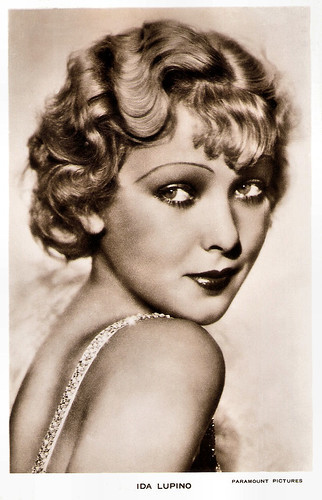
British Real Photograph postcard. Photo: Paramount Pictures.
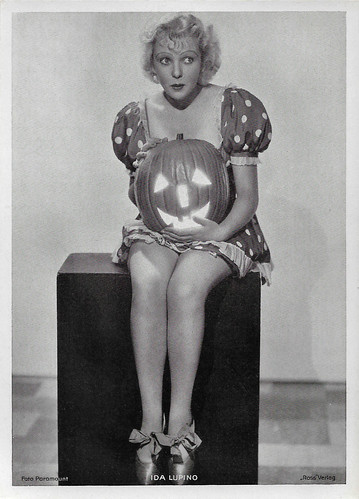
Large German card by Ross Verlag. Photo: Paramount.
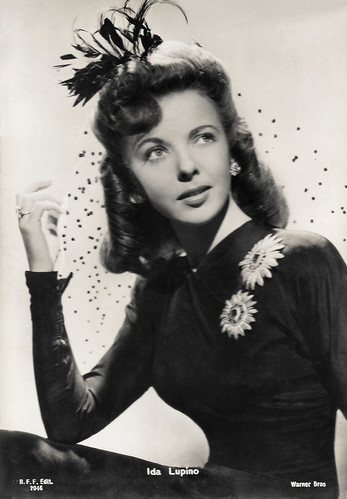
Italian postcard by B.F.F. Edit. (Casa Editr. Ballerini & Fratini, Firenze), no. 2046. Photo: Warner Bros.
The English Jean Harlow
Ida Lupino was born in 1918 in London to a show business family. Her parents were actress Connie O'Shea (also known as Connie Emerald) and music hall entertainer Stanley Lupino, a member of the theatrical Lupino family, which also included Lupino Lane, a popular song-and-dance man.
Her father encouraged Ida to perform at an early age, and built a backyard theatre for her and her sister Rita, who also became an actress and dancer. She wanted to be a writer, but in order to please her father, Lupino enrolled in the Royal Academy of Dramatic Art.
Lupino made her first film appearance in a minor role in The Love Race (Lupino Lane, Pat Morton, 1931), directed by her uncle. In 1933, her mother brought the 14-years-old Ida with her to an audition and Ida got the part her mother wanted. The picture was Her First Affair (Allan Dwan, 1932), and she played a headstrong young girl, who falls completely for a writer of trashy novels.
She played leading roles in five British films in 1933 at Warner Bros.' Teddington studios and for Julius Hagen at Twickenham, including in The Ghost Camera (Bernard Vorhaus, 1933) with John Mills , and I Lived with You (Maurice Elvey, 1933) with Ivor Novello .
Dubbed "the English Jean Harlow ", the bleached blonde came to Hollywood in 1934 and played small and insignificant parts. Peter Ibbetson (Henry Hathaway, 1935) starring Gary Cooper , was one of her few noteworthy films and it was not until The Light That Failed (William A. Wellman, 1939) that she began to be taken seriously as a dramatic actress.
Mark Hellinger, associate producer at Warner Bros., was impressed by Lupino's performance in The Light That Failed, and hired her for the femme-fatale role in They Drive by Night (Raoul Walsh, 1940), opposite George Raft, Ann Sheridan and Humphrey Bogart.
Her parts improved further during the 1940s. In most of her films, she was cast as the hard, but sympathetic woman from the wrong side of the tracks. In The Sea Wolf (Michael Curtiz, 1941) opposite Edward G. Robinson , and High Sierra (Raoul Walsh, 1941) opposite Humphrey Bogart, she played the part magnificently. Tony Fontana at IMDb : "It has been said that no one could do hard-luck dames the way Lupino could do them. She played tough, knowing characters who held their own against some of the biggest leading men of the day".
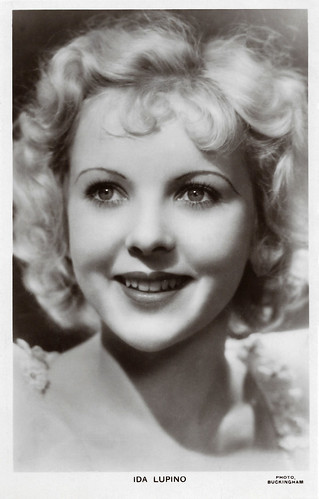
British postcard in the Picturegoer Series, London, no. 786. Photo: Buckingham.
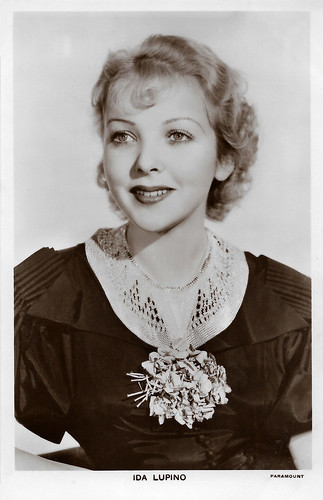
British postcard in the Picturegoer Series, London, no. 786b. Photo: Paramount.
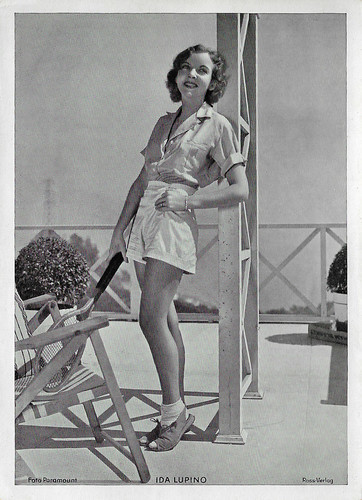
Big German card by Ross Verlag. Photo: Paramount.
The poor man's Don Siegel
Ida Lupino's performance in The Hard Way (Vincent Sherman, 1943) won the New York Film Critics Circle Award for Best Actress. She made a handful of other films during the 1940s playing different characters ranging from Pillow to Post (Vincent Sherman, 1945), where she played a travelling saleswoman to the tough nightclub singer in The Man I Love (Raoul Walsh, 1947) with Robert Alda.
Although in demand throughout the 1940s, she never became a major star, but was critically lauded for her tough, direct acting style. Good roles for women were hard to get. She left Warner Brothers in 1947 and became a freelance actress. She appeared for 20th Century Fox as a nightclub singer in the Film Noir Road House (Jean Negulesco, 1948), performing her musical numbers in the film.
When better roles did not materialise, Ida stepped behind the camera as a director, writer and producer. She and her husband Collier Young formed an independent company, The Filmakers [sic], to produce, direct, and write low-budget, issue-oriented films.
Her first directing job came when director Elmer Clifton fell ill on Not Wanted (1949), with Sally Forrest as an unwed mother. Lupino co-produced and co-wrote the film, and also stepped in to finish the film. Tony Fontana: "Ida had joked that as an actress, she was the poor man's Bette Davis . Now, she said that as a director, she became the poor man's Don Siegel. The films that she wrote, or directed, or appeared in during the fifties were mostly inexpensive melodramas."
Never Fear (Ida Lupino, 1949) with Sally Forrest and Keefe Brasselle, was her first director's credit. Wikipedia : "She became a wily low-budget filmmaker, reusing sets from other studio productions and talking her physician into appearing as a doctor in the delivery scene of Not Wanted. She used what is now called product placement, placing Coke, Cadillac, and other brands in her films. She shot in public places to avoid set-rental costs and planned scenes in pre-production to avoid technical mistakes and retakes."
Her other films include the rape-drama Outrage (Ida Lupino, 1950) with Mala Powers, the thriller The Hitch-Hiker (Ida Lupino, 1953) with Edmond O'Brien, and The Bigamist (Ida Lupino, 1953) with Joan Fontaine and Edmund Gwenn.
She starred in On Dangerous Ground (Nicholas Ray, 1951), and may have taken on some of the directing tasks of the film while director Ray was ill. She later turned to Television where she directed episodes in shows such as The Untouchables (1959), The Fugitive (1963) and The Ghost & Mrs. Muir (1968).
From January 1957 to September 1958, Lupino starred with her then-husband Howard Duff in the sitcom Mr. Adams and Eve, in which the duo played husband-and-wife film stars named Howard Adams and Eve Drake, living in Beverly Hills, California.
In the 1970s, she did guest appearances on various television shows, including Columbo (1972-1974), Police Woman (1975) and Charlie's Angels (1977). She also played Steve McQueen's mother in Junior Bonner (Sam Peckinpah, 1972), and appeared in B-films like the Horror film The Devil's Rain (Robert Fuest, 1975) with Ernest Borgnine, and My Boys Are Good Boys (Bethel Buckalew, 1978) opposite Ralph Meeker, which was her final screen appearance.
She was 60, when she retired from the entertainment business. Ida Lupino was married and divorced three times. She married actor Louis Hayward in 1938. They separated in 1944 and divorced in 1945. Her second marriage was to producer Collier Young in 1948. They divorced in 1951. When Lupino filed for divorce in September that year, she was already pregnant from an affair with future husband Howard Duff. The child was born seven months after she filed for divorce from Young. Lupino's third and final marriage was to actor Howard Duff, whom she married on 21 October 1951. Six months later, their daughter Bridget was born in 1952. Lupino and Duff divorced in 1983.
Ida Lupino died from a stroke while undergoing treatment for colon cancer in Los Angeles in 1995, at the age of 77. Her memoirs, 'Ida Lupino: Beyond the Camera', were edited after her death and published by Mary Ann Anderson.
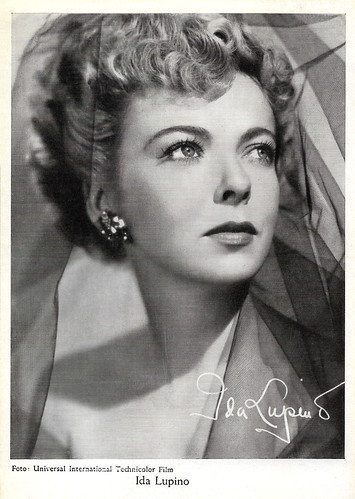
German Collectors Card. Photo: Universal International Technicolor Film.
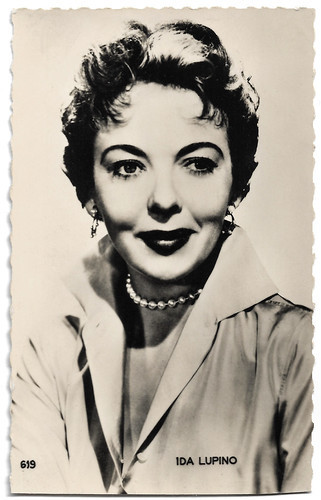
French postcard by Editions P.I., Paris, no. 619. Photo: Warner Bros. The bottom of the card was cut off by a former owner.
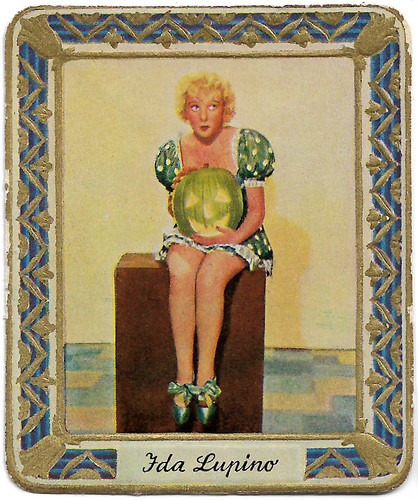
German collectors card in the Moderne Schönheitsgalerie series by Ross Verlag for Kurmark Edelzigarette, no. 142. Photo: Paramount.
Sources: (IMDb), Wikipedia and .

British Real Photograph postcard. Photo: Paramount Pictures.

Large German card by Ross Verlag. Photo: Paramount.

Italian postcard by B.F.F. Edit. (Casa Editr. Ballerini & Fratini, Firenze), no. 2046. Photo: Warner Bros.
The English Jean Harlow
Ida Lupino was born in 1918 in London to a show business family. Her parents were actress Connie O'Shea (also known as Connie Emerald) and music hall entertainer Stanley Lupino, a member of the theatrical Lupino family, which also included Lupino Lane, a popular song-and-dance man.
Her father encouraged Ida to perform at an early age, and built a backyard theatre for her and her sister Rita, who also became an actress and dancer. She wanted to be a writer, but in order to please her father, Lupino enrolled in the Royal Academy of Dramatic Art.
Lupino made her first film appearance in a minor role in The Love Race (Lupino Lane, Pat Morton, 1931), directed by her uncle. In 1933, her mother brought the 14-years-old Ida with her to an audition and Ida got the part her mother wanted. The picture was Her First Affair (Allan Dwan, 1932), and she played a headstrong young girl, who falls completely for a writer of trashy novels.
She played leading roles in five British films in 1933 at Warner Bros.' Teddington studios and for Julius Hagen at Twickenham, including in The Ghost Camera (Bernard Vorhaus, 1933) with John Mills , and I Lived with You (Maurice Elvey, 1933) with Ivor Novello .
Dubbed "the English Jean Harlow ", the bleached blonde came to Hollywood in 1934 and played small and insignificant parts. Peter Ibbetson (Henry Hathaway, 1935) starring Gary Cooper , was one of her few noteworthy films and it was not until The Light That Failed (William A. Wellman, 1939) that she began to be taken seriously as a dramatic actress.
Mark Hellinger, associate producer at Warner Bros., was impressed by Lupino's performance in The Light That Failed, and hired her for the femme-fatale role in They Drive by Night (Raoul Walsh, 1940), opposite George Raft, Ann Sheridan and Humphrey Bogart.
Her parts improved further during the 1940s. In most of her films, she was cast as the hard, but sympathetic woman from the wrong side of the tracks. In The Sea Wolf (Michael Curtiz, 1941) opposite Edward G. Robinson , and High Sierra (Raoul Walsh, 1941) opposite Humphrey Bogart, she played the part magnificently. Tony Fontana at IMDb : "It has been said that no one could do hard-luck dames the way Lupino could do them. She played tough, knowing characters who held their own against some of the biggest leading men of the day".

British postcard in the Picturegoer Series, London, no. 786. Photo: Buckingham.

British postcard in the Picturegoer Series, London, no. 786b. Photo: Paramount.

Big German card by Ross Verlag. Photo: Paramount.
The poor man's Don Siegel
Ida Lupino's performance in The Hard Way (Vincent Sherman, 1943) won the New York Film Critics Circle Award for Best Actress. She made a handful of other films during the 1940s playing different characters ranging from Pillow to Post (Vincent Sherman, 1945), where she played a travelling saleswoman to the tough nightclub singer in The Man I Love (Raoul Walsh, 1947) with Robert Alda.
Although in demand throughout the 1940s, she never became a major star, but was critically lauded for her tough, direct acting style. Good roles for women were hard to get. She left Warner Brothers in 1947 and became a freelance actress. She appeared for 20th Century Fox as a nightclub singer in the Film Noir Road House (Jean Negulesco, 1948), performing her musical numbers in the film.
When better roles did not materialise, Ida stepped behind the camera as a director, writer and producer. She and her husband Collier Young formed an independent company, The Filmakers [sic], to produce, direct, and write low-budget, issue-oriented films.
Her first directing job came when director Elmer Clifton fell ill on Not Wanted (1949), with Sally Forrest as an unwed mother. Lupino co-produced and co-wrote the film, and also stepped in to finish the film. Tony Fontana: "Ida had joked that as an actress, she was the poor man's Bette Davis . Now, she said that as a director, she became the poor man's Don Siegel. The films that she wrote, or directed, or appeared in during the fifties were mostly inexpensive melodramas."
Never Fear (Ida Lupino, 1949) with Sally Forrest and Keefe Brasselle, was her first director's credit. Wikipedia : "She became a wily low-budget filmmaker, reusing sets from other studio productions and talking her physician into appearing as a doctor in the delivery scene of Not Wanted. She used what is now called product placement, placing Coke, Cadillac, and other brands in her films. She shot in public places to avoid set-rental costs and planned scenes in pre-production to avoid technical mistakes and retakes."
Her other films include the rape-drama Outrage (Ida Lupino, 1950) with Mala Powers, the thriller The Hitch-Hiker (Ida Lupino, 1953) with Edmond O'Brien, and The Bigamist (Ida Lupino, 1953) with Joan Fontaine and Edmund Gwenn.
She starred in On Dangerous Ground (Nicholas Ray, 1951), and may have taken on some of the directing tasks of the film while director Ray was ill. She later turned to Television where she directed episodes in shows such as The Untouchables (1959), The Fugitive (1963) and The Ghost & Mrs. Muir (1968).
From January 1957 to September 1958, Lupino starred with her then-husband Howard Duff in the sitcom Mr. Adams and Eve, in which the duo played husband-and-wife film stars named Howard Adams and Eve Drake, living in Beverly Hills, California.
In the 1970s, she did guest appearances on various television shows, including Columbo (1972-1974), Police Woman (1975) and Charlie's Angels (1977). She also played Steve McQueen's mother in Junior Bonner (Sam Peckinpah, 1972), and appeared in B-films like the Horror film The Devil's Rain (Robert Fuest, 1975) with Ernest Borgnine, and My Boys Are Good Boys (Bethel Buckalew, 1978) opposite Ralph Meeker, which was her final screen appearance.
She was 60, when she retired from the entertainment business. Ida Lupino was married and divorced three times. She married actor Louis Hayward in 1938. They separated in 1944 and divorced in 1945. Her second marriage was to producer Collier Young in 1948. They divorced in 1951. When Lupino filed for divorce in September that year, she was already pregnant from an affair with future husband Howard Duff. The child was born seven months after she filed for divorce from Young. Lupino's third and final marriage was to actor Howard Duff, whom she married on 21 October 1951. Six months later, their daughter Bridget was born in 1952. Lupino and Duff divorced in 1983.
Ida Lupino died from a stroke while undergoing treatment for colon cancer in Los Angeles in 1995, at the age of 77. Her memoirs, 'Ida Lupino: Beyond the Camera', were edited after her death and published by Mary Ann Anderson.

German Collectors Card. Photo: Universal International Technicolor Film.

French postcard by Editions P.I., Paris, no. 619. Photo: Warner Bros. The bottom of the card was cut off by a former owner.

German collectors card in the Moderne Schönheitsgalerie series by Ross Verlag for Kurmark Edelzigarette, no. 142. Photo: Paramount.
Sources: (IMDb), Wikipedia and .
Published on November 30, 2019 22:00
November 29, 2019
New acquisitions: Artiste de The Vitagraph Co.
On 5 January this year, EFSP did a post on the American Vitagraph Company, a pioneering film studio which was active during the silent era. The post included some French postcards which were probably published by the French subsidiary of The Vitagraph Co. In contrast to most American film companies, who had London as their hub for the European film distribution market, Vitagraph arranged its European distribution and publicity from Paris, including the astonishing film posters (de)signed by Harry Bedos. Ivo Blom recently acquired more cards of this series, which we share with you today.
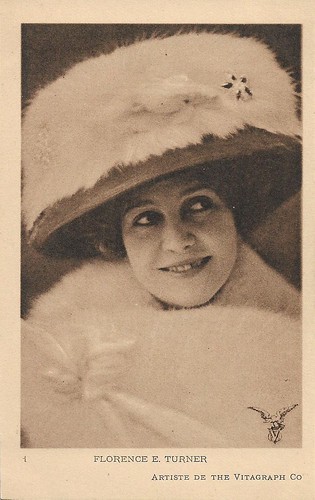
Florence Turner. French postcard in the Artiste of the Vitagraph Co. series, no. 1. The series was probably issued by the Paris subsidiary of The Vitagraph Co. Photo: Stacy, Brooklyn.
Vitagraph made countless contributions to the history of film-making, and created the first American film star, Florence Turner ‘the Vitagraph Girl’. She had made her film debut in How to Cure a Cold (1907). At the time there were no stars per se, unless an already famous stage star made a film. Performers were not even mentioned by name. The Vitagraph Girl became the most popular American actress to appear on screen which was at that time still dominated by French pictures, especially from the Pathé and Gaumont companies. Her worth to the studio, as its biggest box-office draw, was recognised in 1907 when her pay was upped to $22 a week, as proto-star plus part-time seamstress.
Florence was paired several times with heartthrob Wallace Reid, who was also on his way to stardom. In March 1910, Turner and Florence Lawrence became the first American screen actors not already famous in another medium to be publicised by name by their studios to the general public. But with the rise of more stars, such as Mary Pickford at Biograph Studios, Florence Turner was no longer quite as special. By 1913 she was looking for new pastures and left the United States, accompanied by director Laurence Trimble. They moved to Great Britain, where she and Trimble began performing together in London music halls and started their own film company.
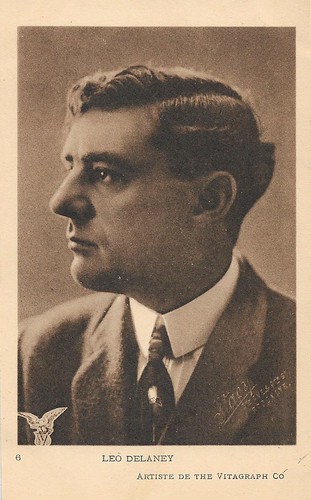
Leo Delaney. French postcard in the Artiste of the Vitagraph Co. series, no. 6. The series was probably issued by the Paris subsidiary of The Vitagraph Co. Photo: Stacy, Brooklyn.
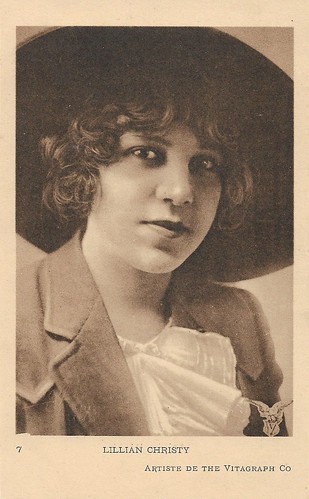
Lillian Christy. French postcard in the Artiste of the Vitagraph Co. series, no. 7. The series was probably issued by the Paris subsidiary of The Vitagraph Co. Photo: Stacy, Brooklyn.
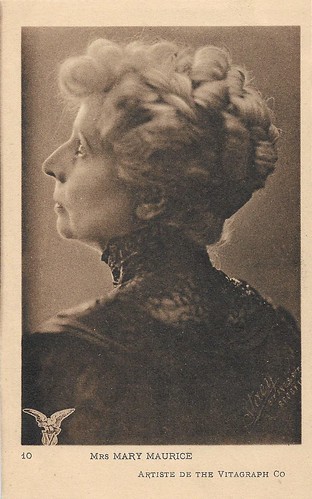
Mrs Mary Maurice. French postcard in the Artiste of the Vitagraph Co. series, no. 10. The series was probably issued by the Paris subsidiary of The Vitagraph Co. Photo: Stacy, Brooklyn.
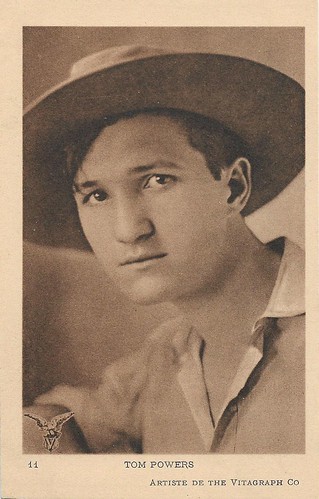
Tom Powers. French postcard in the Artiste of the Vitagraph Co. series, no. 11. The series was probably issued by the Paris subsidiary of The Vitagraph Co.
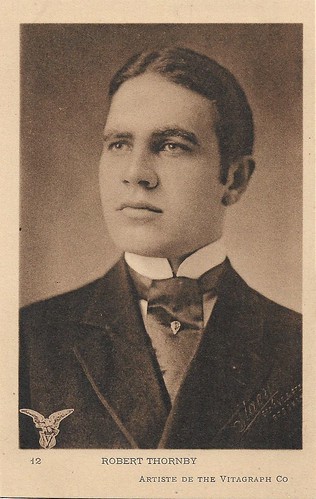
Robert Thornby. French postcard in the Artiste of the Vitagraph Co. series, no. 12. The series was probably issued by the Paris subsidiary of The Vitagraph Co.
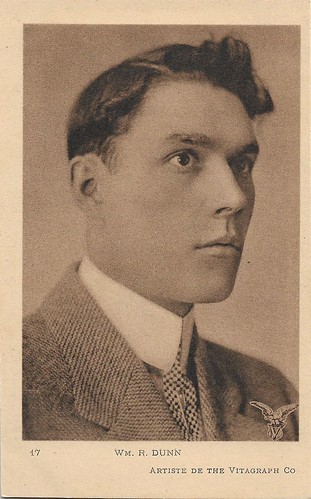
William R. Dunn. French postcard in the Artiste of the Vitagraph Co. series, no. 17. The series was probably issued by the Paris subsidiary of The Vitagraph Co.
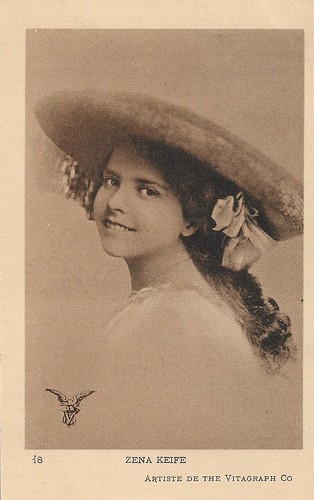
Zena Keife. French postcard in the Artiste of the Vitagraph Co. series, no. 18. The series was probably issued by the Paris subsidiary of The Vitagraph Co.
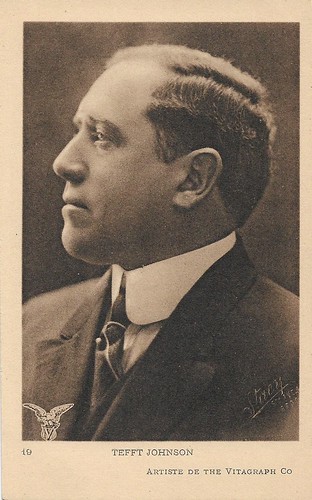
Tefft Johnson. French postcard in the Artiste of the Vitagraph Co. series, no. 19. The series was probably issued by the Paris subsidiary of The Vitagraph Co. Photo: Stacy, Brooklyn.
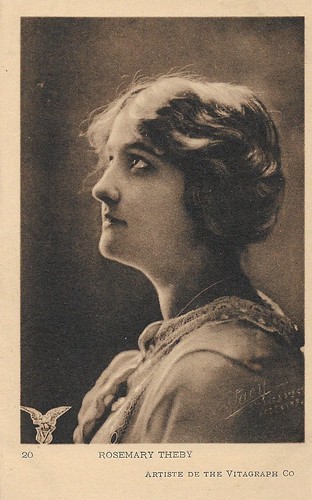
Rosemary Theby. French postcard in the Artiste of the Vitagraph Co. series, no. 20. The series was probably issued by the Paris subsidiary of The Vitagraph Co. Photo: Stacy, Brooklyn.

Florence Turner. French postcard in the Artiste of the Vitagraph Co. series, no. 1. The series was probably issued by the Paris subsidiary of The Vitagraph Co. Photo: Stacy, Brooklyn.
Vitagraph made countless contributions to the history of film-making, and created the first American film star, Florence Turner ‘the Vitagraph Girl’. She had made her film debut in How to Cure a Cold (1907). At the time there were no stars per se, unless an already famous stage star made a film. Performers were not even mentioned by name. The Vitagraph Girl became the most popular American actress to appear on screen which was at that time still dominated by French pictures, especially from the Pathé and Gaumont companies. Her worth to the studio, as its biggest box-office draw, was recognised in 1907 when her pay was upped to $22 a week, as proto-star plus part-time seamstress.
Florence was paired several times with heartthrob Wallace Reid, who was also on his way to stardom. In March 1910, Turner and Florence Lawrence became the first American screen actors not already famous in another medium to be publicised by name by their studios to the general public. But with the rise of more stars, such as Mary Pickford at Biograph Studios, Florence Turner was no longer quite as special. By 1913 she was looking for new pastures and left the United States, accompanied by director Laurence Trimble. They moved to Great Britain, where she and Trimble began performing together in London music halls and started their own film company.

Leo Delaney. French postcard in the Artiste of the Vitagraph Co. series, no. 6. The series was probably issued by the Paris subsidiary of The Vitagraph Co. Photo: Stacy, Brooklyn.

Lillian Christy. French postcard in the Artiste of the Vitagraph Co. series, no. 7. The series was probably issued by the Paris subsidiary of The Vitagraph Co. Photo: Stacy, Brooklyn.

Mrs Mary Maurice. French postcard in the Artiste of the Vitagraph Co. series, no. 10. The series was probably issued by the Paris subsidiary of The Vitagraph Co. Photo: Stacy, Brooklyn.

Tom Powers. French postcard in the Artiste of the Vitagraph Co. series, no. 11. The series was probably issued by the Paris subsidiary of The Vitagraph Co.

Robert Thornby. French postcard in the Artiste of the Vitagraph Co. series, no. 12. The series was probably issued by the Paris subsidiary of The Vitagraph Co.

William R. Dunn. French postcard in the Artiste of the Vitagraph Co. series, no. 17. The series was probably issued by the Paris subsidiary of The Vitagraph Co.

Zena Keife. French postcard in the Artiste of the Vitagraph Co. series, no. 18. The series was probably issued by the Paris subsidiary of The Vitagraph Co.

Tefft Johnson. French postcard in the Artiste of the Vitagraph Co. series, no. 19. The series was probably issued by the Paris subsidiary of The Vitagraph Co. Photo: Stacy, Brooklyn.

Rosemary Theby. French postcard in the Artiste of the Vitagraph Co. series, no. 20. The series was probably issued by the Paris subsidiary of The Vitagraph Co. Photo: Stacy, Brooklyn.
Published on November 29, 2019 22:00
November 28, 2019
Yes, EFSP's got a record!
Although November 2019 is not over yet, EFSP's numbers fetishist just called us to announce that we have a record. So far, Blogger counted more than 128,000 visits to our blog this month. Our best number since we started counting in 2008, was 126,964 visits in January 2017. And we easily broke that record. Thanks. We're so glad that you keep coming back for more or that just have discovered this little labour of love. Below, we have invited some friends for a little party. Join the fun!
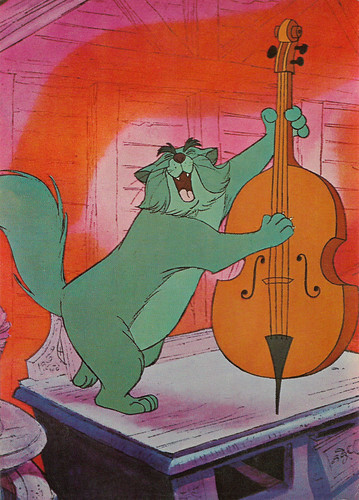
French postcard. Illustration: Walt Disney Productions. Publicity still for The AristoCats (Wolfgang Reitherman, 1970).
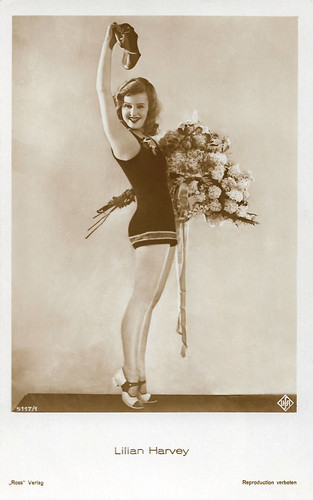
German postcard by Ross Verlag, no. 5117/1, 1930-1931. Photo: Ufa.
British born, German party girl and actress Lilian Harvey (1906-1968) was Ufa's biggest star of the 1930s. With Willy Fritsch , she formed the 'Dream Team of the European Cinema'. Their best film was the immensely popular film operetta Der Kongress tanzt/The Congress Dances (Erik Charell, 1931).

French postcard by Editions du Globe, no. 473. Photo: 20th Century Fox.
American party girl Jane Russell (1921-2011) was one of Hollywood's leading sex symbols in the 1940s and 1950s. She had her first film role in 1943 in Howard Hughes' The Outlaw. In 1947, Russell delved into music. Her film career revived when she was cast as Calamity Jane opposite Bob Hope in The Paleface (1948). After starring in several films in the 1950s, including Gentlemen Prefer Blondes (1953), Russell again returned to music while completing several other films in the 1960s. She starred in more than 20 films throughout her career.
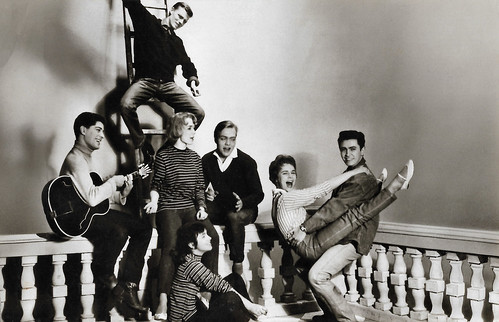
German postcard by Hans Josef Rüdel, Filmpostkartenverlag, Hamburg-Bergedorf, no. 2647. Photo: H.P. / Union / Haenchen. Conny Froboess , Rex Gildo , Richard Hellmann , Elke Arendt, Monika Leonhardt, Sergio Casmai and Hans Zander in Hula-Hopp, Conny (Heinz Paul, 1959).
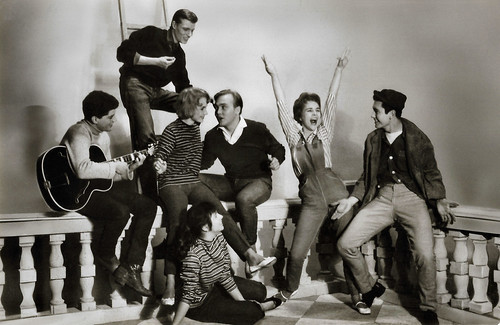
German postcard by Hans Josef Rüdel, Filmpostkartenverlag, Hamburg-Bergedorf, no. 2649. Photo: H.P. / Union / Haenchen. Conny Froboess , Rex Gildo , Richard Hellmann , Elke Arendt, Monika Leonhardt, Sergio Casmai and Hans Zander in Hula-Hopp, Conny (Heinz Paul, 1959).
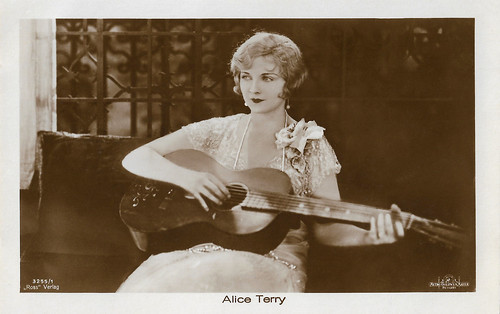
German postcard by Ross Verlag, no. 3255/1, 1928-1929. Photo: Metro-Goldwyn-Mayer (MGM). Alice Terry in Lovers? (John M. Stahl, 1927).
Alice Terry, originally Alice Frances Taeffe (1900–1987) was an American film actress and director, who began her career during the silent film era and appeared in almost 40 films between 1916 and 1933. Though a brunette, Terry's trademark look was her blond hair, for which she wore wigs from 1920 onwards, e.g. in her most acclaimed role in The Four Horsemen of the Apocalypse (Rex Ingram, 1921) starring Rudolph Valentino . Ingram, who married her in 1921, would shoot her in many of his films and often paired her to Ramon Novarro , but also to other ‘Latin Lovers’ such as Antonio Moreno. Later on, Terry proved in films without her husband’s direction she was a legitimate star. In 1923 the couple moved to the French Riviera, where they set up a small studio in Nice and made several films on location in North Africa, Spain, and Italy for MGM and others. In the later 1920s, they returned to Los Angeles. In 1933, Terry made her last film appearance in Baroud, which she also co-directed with her husband, and which was partly shot in Morocco.
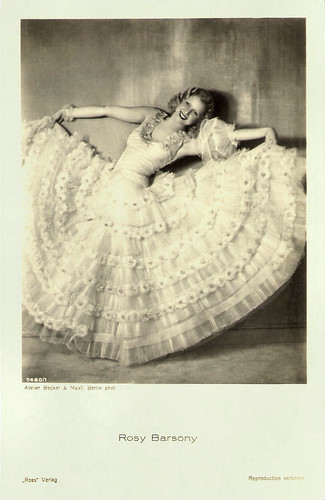
German postcard by Ross Verlag, no. 7480/1, 1932-1933. Photo: Becker & Maass, Berlin.
Hungarian actress, dancer and singer Rose Barsony (1909-1977) appeared in 16 films from 1929 to 1938, and in one more in 1957. The soubrette was a popular star of the operettas by Paul Abraham.

German postcard. Ross Verlag, No. 79/5. Henny Porten-Froehlich Produktion GmbH. Henny Porten and Walter Slezak in the German silent film Die grosse Pause (Carl Froehlich, 1927).
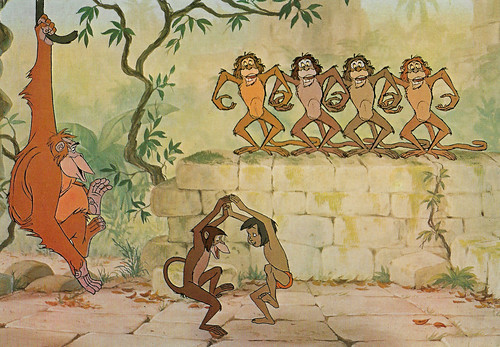
Belgian postcard by Edicorna, no. 3321. Image: Walt Disney Productions. Publicity still for The Jungle Book (Wolfgang Reitherman, 1967).
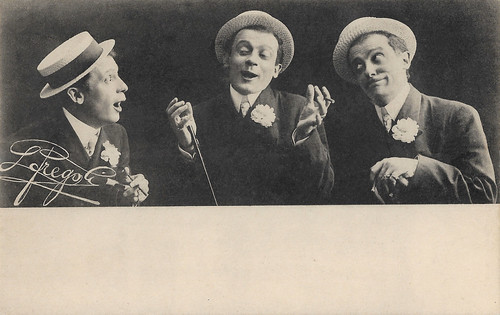
Italian postcard by Garzini e Pezzini, Milano, 1908.
Leopoldo Fregoli (1867-1936) was one of the first vaudeville actors who used film in his acts. Fregoli was famous for his rapid transformation acts, in which he did impersonations of famous artistic and political characters. In 1898 he bought a Cinematographe from the Lumière brothers and started to show shorts, named Fregoligraph, as part of his stage act. They were recordings of his transformation acts.
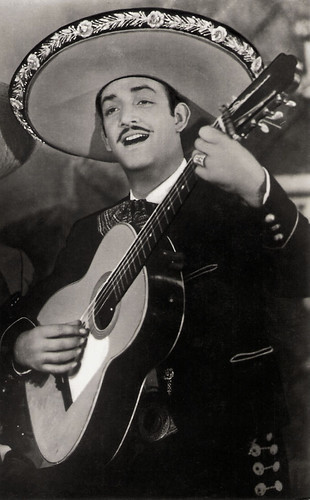
Spanish postcard by P.M., Bilbao, no. 3018.
Mexican singer and actor Jorge Negrete (1911-1953) was for many years considered the number 1 entertainer in Latin America. More than 50 years after his death, he is still an icon in Mexico, Spain, and Latin America. His rendition of 'México Lindo y Querido' (Beautiful and Beloved México), his country’s unofficial anthem, is an evergreen. Typical is his manly, arrogant yet good-humoured singing and romantic image, dressed in Charro (cowboy) attire. 'El Charro Cantor' appeared in 44 films.
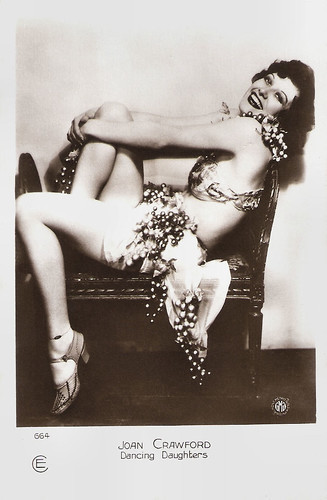
French postcard by Cinémagazine-Edition, no. 664. Photo: MGM. Joan Crawford in Our Dancing Daughters (Harry Beaumont, 1928).
American actress Joan Crawford (1905-1977) became nationally-known as a flapper by the end of the 1920s. In the 1930s, her fame rivalled, and later outlasted, MGM colleagues Norma Shearer and Greta Garbo . Crawford often played hardworking young women who find romance and success. These 'rags-to-riches' stories were well received by Depression-era audiences and were popular with women. Crawford became one of Hollywood's most prominent movie stars and one of the highest-paid women in the United States, but her films began losing money and by the end of the 1930s she was labelled 'Box Office Poison'. But her career gradually improved in the early 1940s, and she made a major comeback in 1945 by starring in Mildred Pierce, for which she won the Academy Award for Best Actress.
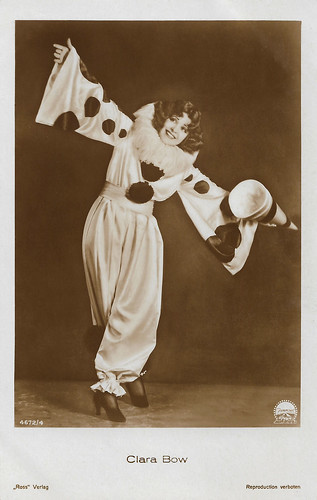
German postcard by Ross-Verlag, no. 4672/4, 1928-1929. Photo: Paramount.
American actress Clara Bow (1905-1965) rose to stardom in silent film during the 1920s. It was her appearance as a plucky shopgirl in the film It (Clarence G. Badger, 1927) that brought her global fame and the nickname 'The It Girl'. Bow came to personify the Roaring Twenties and is described as its leading sex symbol.
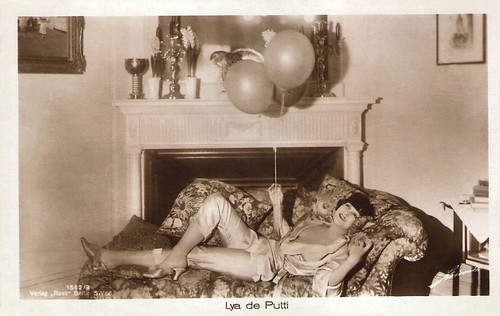
German postcard by Ross Verlag, Berlin, no. 1562/3, 1927-1928. The signature of the photographer could be "Freimuth", but also "Lutteroth", a photographer in Munich whose work was used by Ross, or "Kurzrock", a photographer from Wiesbaden whose work Ross also used.
Lya de Putti (1899-1931) portrayed vamps in German and American silent films.

German postcard by Ross Verlag, no. 4453/2, 1929-1930. Photo: Lothar Stark-Film. Collection: Geoffrey Donaldson Institute.
The Danish double-act Fy og Bi (Fyrtårnet og Bivognen aka Pat & Patachon) was the most famous comedy couple of the European silent cinema. Long Carl Schenstrom (1881-1942) and short Harald Madsen (1890-1949) became very popular in the 1920s with their short slapstick films.
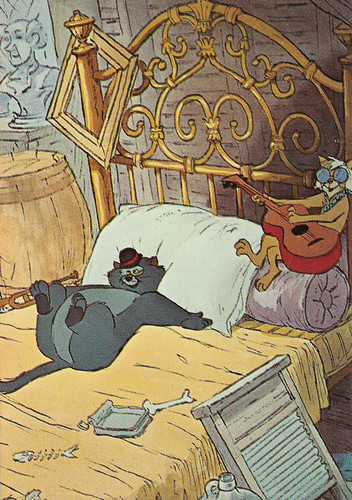
French postcard. Illustration: Walt Disney Productions. Publicity still for The AristoCats (Wolfgang Reitherman, 1970).

French postcard. Illustration: Walt Disney Productions. Publicity still for The AristoCats (Wolfgang Reitherman, 1970).

German postcard by Ross Verlag, no. 5117/1, 1930-1931. Photo: Ufa.
British born, German party girl and actress Lilian Harvey (1906-1968) was Ufa's biggest star of the 1930s. With Willy Fritsch , she formed the 'Dream Team of the European Cinema'. Their best film was the immensely popular film operetta Der Kongress tanzt/The Congress Dances (Erik Charell, 1931).

French postcard by Editions du Globe, no. 473. Photo: 20th Century Fox.
American party girl Jane Russell (1921-2011) was one of Hollywood's leading sex symbols in the 1940s and 1950s. She had her first film role in 1943 in Howard Hughes' The Outlaw. In 1947, Russell delved into music. Her film career revived when she was cast as Calamity Jane opposite Bob Hope in The Paleface (1948). After starring in several films in the 1950s, including Gentlemen Prefer Blondes (1953), Russell again returned to music while completing several other films in the 1960s. She starred in more than 20 films throughout her career.

German postcard by Hans Josef Rüdel, Filmpostkartenverlag, Hamburg-Bergedorf, no. 2647. Photo: H.P. / Union / Haenchen. Conny Froboess , Rex Gildo , Richard Hellmann , Elke Arendt, Monika Leonhardt, Sergio Casmai and Hans Zander in Hula-Hopp, Conny (Heinz Paul, 1959).

German postcard by Hans Josef Rüdel, Filmpostkartenverlag, Hamburg-Bergedorf, no. 2649. Photo: H.P. / Union / Haenchen. Conny Froboess , Rex Gildo , Richard Hellmann , Elke Arendt, Monika Leonhardt, Sergio Casmai and Hans Zander in Hula-Hopp, Conny (Heinz Paul, 1959).

German postcard by Ross Verlag, no. 3255/1, 1928-1929. Photo: Metro-Goldwyn-Mayer (MGM). Alice Terry in Lovers? (John M. Stahl, 1927).
Alice Terry, originally Alice Frances Taeffe (1900–1987) was an American film actress and director, who began her career during the silent film era and appeared in almost 40 films between 1916 and 1933. Though a brunette, Terry's trademark look was her blond hair, for which she wore wigs from 1920 onwards, e.g. in her most acclaimed role in The Four Horsemen of the Apocalypse (Rex Ingram, 1921) starring Rudolph Valentino . Ingram, who married her in 1921, would shoot her in many of his films and often paired her to Ramon Novarro , but also to other ‘Latin Lovers’ such as Antonio Moreno. Later on, Terry proved in films without her husband’s direction she was a legitimate star. In 1923 the couple moved to the French Riviera, where they set up a small studio in Nice and made several films on location in North Africa, Spain, and Italy for MGM and others. In the later 1920s, they returned to Los Angeles. In 1933, Terry made her last film appearance in Baroud, which she also co-directed with her husband, and which was partly shot in Morocco.

German postcard by Ross Verlag, no. 7480/1, 1932-1933. Photo: Becker & Maass, Berlin.
Hungarian actress, dancer and singer Rose Barsony (1909-1977) appeared in 16 films from 1929 to 1938, and in one more in 1957. The soubrette was a popular star of the operettas by Paul Abraham.

German postcard. Ross Verlag, No. 79/5. Henny Porten-Froehlich Produktion GmbH. Henny Porten and Walter Slezak in the German silent film Die grosse Pause (Carl Froehlich, 1927).

Belgian postcard by Edicorna, no. 3321. Image: Walt Disney Productions. Publicity still for The Jungle Book (Wolfgang Reitherman, 1967).

Italian postcard by Garzini e Pezzini, Milano, 1908.
Leopoldo Fregoli (1867-1936) was one of the first vaudeville actors who used film in his acts. Fregoli was famous for his rapid transformation acts, in which he did impersonations of famous artistic and political characters. In 1898 he bought a Cinematographe from the Lumière brothers and started to show shorts, named Fregoligraph, as part of his stage act. They were recordings of his transformation acts.

Spanish postcard by P.M., Bilbao, no. 3018.
Mexican singer and actor Jorge Negrete (1911-1953) was for many years considered the number 1 entertainer in Latin America. More than 50 years after his death, he is still an icon in Mexico, Spain, and Latin America. His rendition of 'México Lindo y Querido' (Beautiful and Beloved México), his country’s unofficial anthem, is an evergreen. Typical is his manly, arrogant yet good-humoured singing and romantic image, dressed in Charro (cowboy) attire. 'El Charro Cantor' appeared in 44 films.

French postcard by Cinémagazine-Edition, no. 664. Photo: MGM. Joan Crawford in Our Dancing Daughters (Harry Beaumont, 1928).
American actress Joan Crawford (1905-1977) became nationally-known as a flapper by the end of the 1920s. In the 1930s, her fame rivalled, and later outlasted, MGM colleagues Norma Shearer and Greta Garbo . Crawford often played hardworking young women who find romance and success. These 'rags-to-riches' stories were well received by Depression-era audiences and were popular with women. Crawford became one of Hollywood's most prominent movie stars and one of the highest-paid women in the United States, but her films began losing money and by the end of the 1930s she was labelled 'Box Office Poison'. But her career gradually improved in the early 1940s, and she made a major comeback in 1945 by starring in Mildred Pierce, for which she won the Academy Award for Best Actress.

German postcard by Ross-Verlag, no. 4672/4, 1928-1929. Photo: Paramount.
American actress Clara Bow (1905-1965) rose to stardom in silent film during the 1920s. It was her appearance as a plucky shopgirl in the film It (Clarence G. Badger, 1927) that brought her global fame and the nickname 'The It Girl'. Bow came to personify the Roaring Twenties and is described as its leading sex symbol.

German postcard by Ross Verlag, Berlin, no. 1562/3, 1927-1928. The signature of the photographer could be "Freimuth", but also "Lutteroth", a photographer in Munich whose work was used by Ross, or "Kurzrock", a photographer from Wiesbaden whose work Ross also used.
Lya de Putti (1899-1931) portrayed vamps in German and American silent films.

German postcard by Ross Verlag, no. 4453/2, 1929-1930. Photo: Lothar Stark-Film. Collection: Geoffrey Donaldson Institute.
The Danish double-act Fy og Bi (Fyrtårnet og Bivognen aka Pat & Patachon) was the most famous comedy couple of the European silent cinema. Long Carl Schenstrom (1881-1942) and short Harald Madsen (1890-1949) became very popular in the 1920s with their short slapstick films.

French postcard. Illustration: Walt Disney Productions. Publicity still for The AristoCats (Wolfgang Reitherman, 1970).
Published on November 28, 2019 22:00
November 27, 2019
Stefan Danailov (1942-2019)
Yesterday, 27 November 2019, Bulgarian actor Stefan Danailov (1942-2019) passed away. He starred in over 100 Bulgarian and foreign films, including the Bulgarian classic At each kilometer(1969) and was seen as 'the Bulgarian Alain Delon'. Danailov was part of the ensemble of the National Theatre from 1979 until his death. Apart from his acting work, Stefan Danailov was an MP for the Bulgarian Socialist Party (BSP). He was a former Minister of Culture, and was also the BSP Deputy Chairman. 'The legend of Bulgarian cinema' was 76.
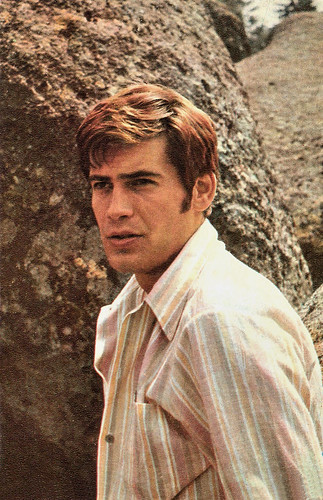
Russian postcard, 1975.
A key from a secret apartmentStefan Lambov Danailov (Стефан Ламбов Данаилов) was born in 1942 in Sofia, Bulgaria.
At the age of 14 his film career started. The first film Danailov took part in Sledite ostavat/Следите остават/The Traces Remain (Petar B. Vasilev, 1956). It was a cold war drama about a group of kids who find a key from a secret apartment where saboteurs are hiding.
At that time Stefan did not want to be an actor but in 1962, he started to study at the famous Krastyo Sarafov National Academy for Theatre and Film Arts. In 1966 he graduated and joined the company of the Drama Theatre in Plovdiv.
His first film roles were in Moreto/The Sea (Peter Donev, 1967) and S dakh na bademi/Taste of Almonds (Lyubomir Sharlandzhiev, 1967).
His best-known role was as Major Deyanov in the TV series Na vseki kilometar/На всеки километър/At Each Kilometer (Nedelcho Chernev, Lyubomir Sharlandzhiev, 1969). The film tells the history of Bulgaria from the anti-fascist uprising in 1923 to the mid-1970s. It became one of the most emblematic films of the communist era in Bulgaria.
For a while Danailov took a break from the theatre, but in 1973 he joined the company of the Bulgarian Army Theatre in Sofia, and in 1979 he became part of the company of the National Theatre in the capital city.
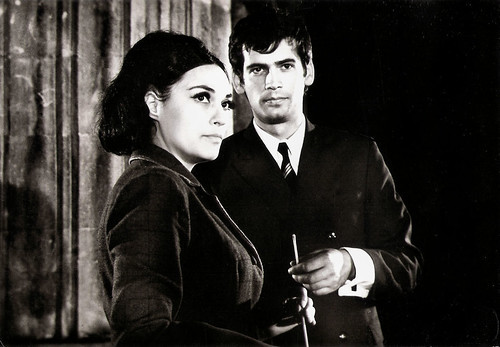
Bulgarian postcard. Stefan Danailov and Stefka Berova in Na vseki kilometar/At each kilometer (1969).
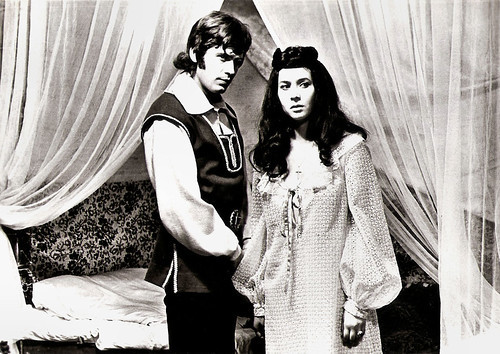
Bulgarian postcard. Stefan Danailov and Dorotea Toncheva in Knyazat/The Prince (Petar B. Vasilev, 1970).
Minister of Culture of Bulgaria
Starting in 1994, Stefan Danailov starred in many productions of the Italian Rai TV. The actor also had been teaching acting at the Bulgarian Theatre Academy since 1988 and in 1996 he became a professor at the institution.
Between August 2005 and July 2009, he served as Minister of Culture of Bulgaria. Among his later films were the Italian drama La masseria delle allodole/The Lark Farm (Paolo and Vittorio Taviani, 2007) about the Armenian Genocide, and the Serbian war drama Sveti Georgije ubiva aždahu/Свети Георгије убива аждаху/St. George Shoots the Dragon (Srđan Dragojević, 2009), one of the most expensive Serbian movie productions to date.
His death in the early morning of 27 November 2019 was announced by the Military Medical Academy. For a month he was in the intensive care unit of the Military Medical Academy, where he was put in medically induced coma.
Bulgaria’s National Assembly began its yesterday’s sitting with a moment of silence for Danailov, who had been a long-serving MP. President Roumen Radev, whose candidacy in the 2016 election was put forward by an initiative committee headed by Danailov, paid tribute to him as “one of the most beloved actors of our time”.
Danailov was married to Maria Dimitrova Danailova, and the couple had one child. Stefan Danailov was the recipient of numerous international awards. He was decorated with the Stara Planina state order for his contribution to culture, and in 2002 he received the Paisii of Hilendar Award for outstanding contribution to Bulgarian culture.
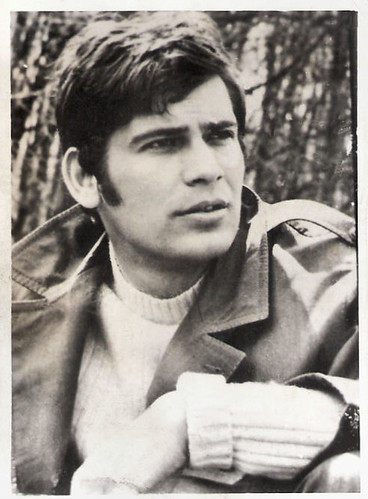
Romanian collectors card.
Sources: (IMDb), Novinite.com, Sofiaglobe.com, Wikipedia and .

Russian postcard, 1975.
A key from a secret apartmentStefan Lambov Danailov (Стефан Ламбов Данаилов) was born in 1942 in Sofia, Bulgaria.
At the age of 14 his film career started. The first film Danailov took part in Sledite ostavat/Следите остават/The Traces Remain (Petar B. Vasilev, 1956). It was a cold war drama about a group of kids who find a key from a secret apartment where saboteurs are hiding.
At that time Stefan did not want to be an actor but in 1962, he started to study at the famous Krastyo Sarafov National Academy for Theatre and Film Arts. In 1966 he graduated and joined the company of the Drama Theatre in Plovdiv.
His first film roles were in Moreto/The Sea (Peter Donev, 1967) and S dakh na bademi/Taste of Almonds (Lyubomir Sharlandzhiev, 1967).
His best-known role was as Major Deyanov in the TV series Na vseki kilometar/На всеки километър/At Each Kilometer (Nedelcho Chernev, Lyubomir Sharlandzhiev, 1969). The film tells the history of Bulgaria from the anti-fascist uprising in 1923 to the mid-1970s. It became one of the most emblematic films of the communist era in Bulgaria.
For a while Danailov took a break from the theatre, but in 1973 he joined the company of the Bulgarian Army Theatre in Sofia, and in 1979 he became part of the company of the National Theatre in the capital city.

Bulgarian postcard. Stefan Danailov and Stefka Berova in Na vseki kilometar/At each kilometer (1969).

Bulgarian postcard. Stefan Danailov and Dorotea Toncheva in Knyazat/The Prince (Petar B. Vasilev, 1970).
Minister of Culture of Bulgaria
Starting in 1994, Stefan Danailov starred in many productions of the Italian Rai TV. The actor also had been teaching acting at the Bulgarian Theatre Academy since 1988 and in 1996 he became a professor at the institution.
Between August 2005 and July 2009, he served as Minister of Culture of Bulgaria. Among his later films were the Italian drama La masseria delle allodole/The Lark Farm (Paolo and Vittorio Taviani, 2007) about the Armenian Genocide, and the Serbian war drama Sveti Georgije ubiva aždahu/Свети Георгије убива аждаху/St. George Shoots the Dragon (Srđan Dragojević, 2009), one of the most expensive Serbian movie productions to date.
His death in the early morning of 27 November 2019 was announced by the Military Medical Academy. For a month he was in the intensive care unit of the Military Medical Academy, where he was put in medically induced coma.
Bulgaria’s National Assembly began its yesterday’s sitting with a moment of silence for Danailov, who had been a long-serving MP. President Roumen Radev, whose candidacy in the 2016 election was put forward by an initiative committee headed by Danailov, paid tribute to him as “one of the most beloved actors of our time”.
Danailov was married to Maria Dimitrova Danailova, and the couple had one child. Stefan Danailov was the recipient of numerous international awards. He was decorated with the Stara Planina state order for his contribution to culture, and in 2002 he received the Paisii of Hilendar Award for outstanding contribution to Bulgarian culture.

Romanian collectors card.
Sources: (IMDb), Novinite.com, Sofiaglobe.com, Wikipedia and .
Published on November 27, 2019 22:00
November 26, 2019
Il processo Clémenceau (1917)
The Spanish chocolaterie Amatller Marca Luna chocolate published this series of postcards of the Italian film Il processo Clémenceau/The Clemenceau Affair (Alfredo De Antoni, 1917), starring Francesca Bertini. In Spain the film was released as El proceso Clemenceau. The young Vittorio De Sica made his film debut in the production.
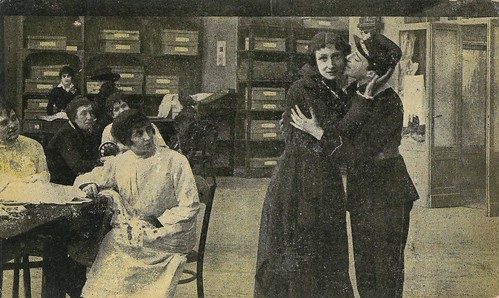
Spanish postcard by Amatller Marca Luna chocolate, Series 2a, no. 1. Photo: Caesar Film. A young Vittorio De Sica in Il processo Clémenceau (Alfredo De Antoni, 1917). In the film, this scene is mirrored. Young Pierre Clemenceau tells his mother he has won the first prize and may start working at the sculptor studio of the father of his friend Costantino.
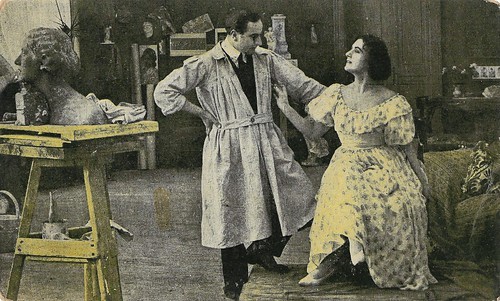
Spanish postcard by Amatller Marca Luna chocolate, Series 2a, no. 6. Photo: Caesar Film. Francesca Bertini and Gustavo Serena in Il processo Clémenceau (Alfredo De Antoni, 1917).
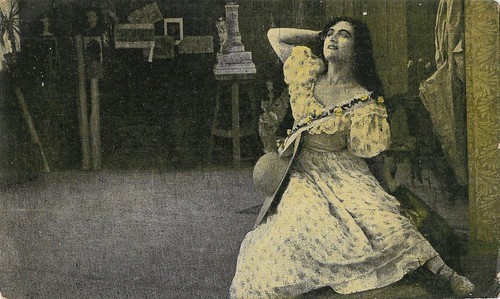
Spanish postcard by Amatller Marca Luna chocolate, Series 2a, no. 7. Photo: Caesar Film. Francesca Bertini in Il processo Clémenceau (Alfredo De Antoni, 1917).
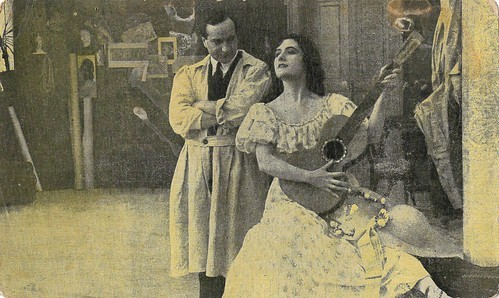
Spanish postcard by Amatller Marca Luna chocolate, Series 2a, no. 8. Photo: Caesar Film. Francesca Bertini and Gustavo Serena in Il processo Clémenceau (Alfredo De Antoni, 1917).
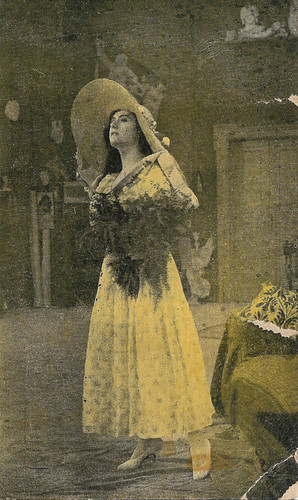
Spanish postcard by Amatller Marca Luna chocolate, Series 2a, no. 9. Photo: Caesar Film. Francesca Bertini in Il processo Clémenceau (Alfredo De Antoni, 1917).
Why he killed his wife
In Il processo Clémenceau/The Clemenceau Affair (Alfredo De Antoni, 1917), the sculptor Pierre Clemenceau ( Gustavo Serena ), imprisoned and waiting for his trial, writes why he killed his wife, played by diva Francesca Bertini .
As a young man of poor descent ( Vittorio De Sica ), he is fortunate to start training with the acclaimed sculptor Ritz, father of his school friend Costantino.
Years after, he has become a sculptor himself and meets the young impoverished Polish countess Iza Dobronowska ( Francesca Bertini ), who models for him for a bust. They fall in love and are betrothed, but Iza's scheming and gold-digging aunt Mathilde (Nella Montagna) has also awakened Iza's lust for money and luxury.
The aunt takes Iza away from Pierre to Poland, in order to get hold of their family patrimony. In Poland, Mathilde connects Iza with a young prince, Sergio ( Lido Manetti a.k.a. Arnold Kent), who indebts himself for the two women. His father finds out and takes action: he exiles his son to the Caucasus and denounces the two women, who lose everything.
Iza writes a letter of pardon to Pierre and asks him to take her away, which he does. He takes her to Paris and marries her. They also get a child. Mathilde hasn't given up and comes to Paris with Sergio, who has fled from the Caucasus. Iza is once more dazzled and cheated by their highlife and abandons Pierre a second time.
An additional complication is the middle-class morality of Pierre's mother which disgusts Iza. The mother dies of an attack before she can tell Pierre about his wife's adultery and behaviour. But when he finds Iza's bust at Sergio's place, he destroys the bust representing her and defies Sergio to a duel, killing him.
Pierre's best friend Costantino (played by director Alfredo De Antoni himself) meets Iza in a restaurant and is abhorred by her behaviour, but in the end, she knows she can seduce any man. Pierre stops working and retreats to Rome. When Pierre meets her time after, Iza is repenting and longs for her lost child. They have one last night of love, after which he kills her in a blind rage, unable to cope with her behaviour and not believing in her moral contrition. So the artist creates but also destroys both his artwork and the model.
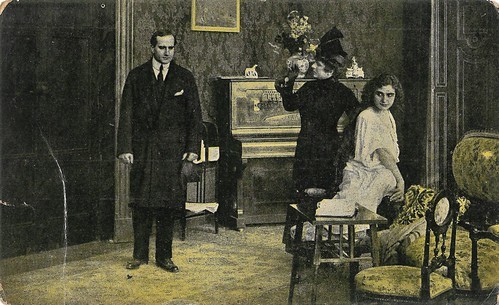
Spanish postcard by Amatller Marca Luna chocolate, Series 2a, no. 10. Photo: Caesar Film. Francesca Bertini , Nella Montagna and Gustavo Serena in Il processo Clémenceau (Alfredo De Antoni, 1917).
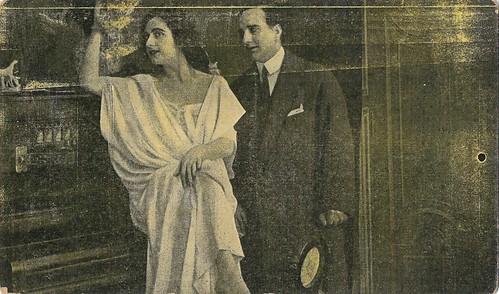
Spanish postcard by Amatller Marca Luna chocolate, Series 2a, no. 11. Photo: Caesar Film. Francesca Bertini and Gustavo Serena in Il processo Clémenceau (Alfredo De Antoni, 1917).
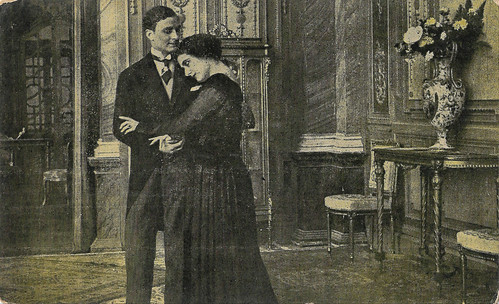
Spanish postcard by Amatller Marca Luna chocolate, Series 2a, no. 13. Photo: Caesar Film. Lido Manetti and Francesca Bertini in Il processo Clémenceau (Alfredo De Antoni, 1917).
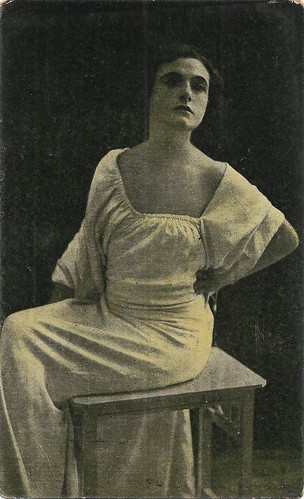
Spanish postcard by Amatller Marca Luna chocolate, Series 2a, no. 14. Photo: Caesar Film. Francesca Bertini in Il processo Clémenceau (Alfredo De Antoni, 1917).
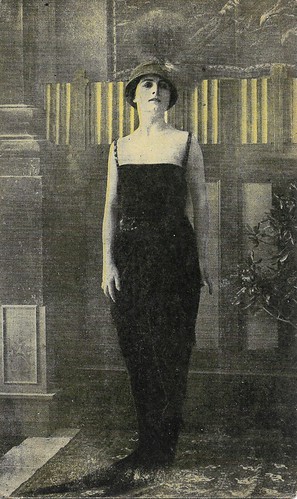
Spanish postcard by Amatller Marca Luna chocolate, Series 2a, no. 16. Photo: Caesar Film. Francesca Bertini in Il processo Clémenceau (Alfredo De Antoni, 1917).
A massive audience
Il processo Clémenceau/The Clemenceau Affair (Alfredo De Antoni, 1917) was based on a play by Alexandre Dumas fils, L'affaire Clémenceau (1866), and scripted by director Alfredo De Antoni and Giuseppe Paolo Pacchierotti.
The cinematography was by Alberto Carta, and the sets were created by Alfredo Manzi. The film was produced by Caesar Film.
While the Roman press was extremely positive about the story and Bertini's interpretation, the Turinese press was more critical about the complicated storyline and the actors' performances but had to admit that the audience was so massive that on a Sunday, two weeks after the premiere, the armed forces had to assist when thousands could not get a place anymore.
A positive nitrate print of the film was found at the Filmoteca de la Generalitat de Valencia and restored by the Cineteca del Comune di Bologna. Clips from the film were used in the Dutch film Diva dolorosa (1999) by Peter Delpeut.
In 1993, Il processo Clémenceau/The Clemenceau Affair (Alfredo De Antoni, 1917) was restaurated by the Cineteca di Bologna. You can see the full film at YouTube.
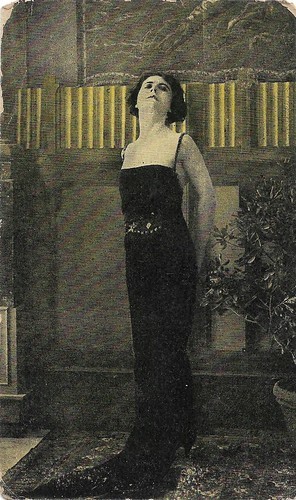
Spanish postcard by Amatller Marca Luna chocolate, Series 2a, no. 17. Photo: Caesar Film. Francesca Bertini in Il processo Clémenceau (Alfredo De Antoni, 1917).
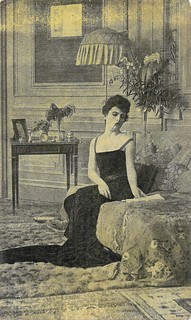
Spanish postcard by Amatller Marca Luna chocolate, Series 2a, no. 18. Photo: Caesar Film. Francesca Bertini in Il processo Clémenceau (Alfredo De Antoni, 1917).

Spanish postcard by Amatller Marca Luna chocolate, Series 2a, no. 19. Photo: Caesar Film. Alfredo de Antoni and Francesca Bertini in Il processo Clémenceau (Alfredo De Antoni, 1917).
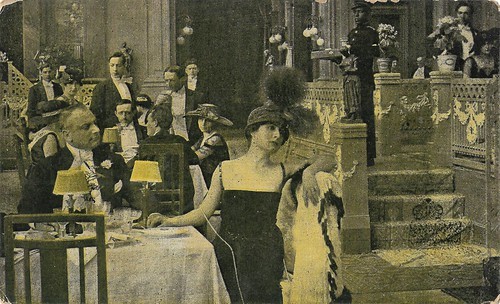
Spanish postcard by Amatller Marca Luna chocolate, Series 2a, no. 20. Photo: Caesar Film. Francesca Bertini in Il processo Clémenceau (Alfredo De Antoni, 1917).
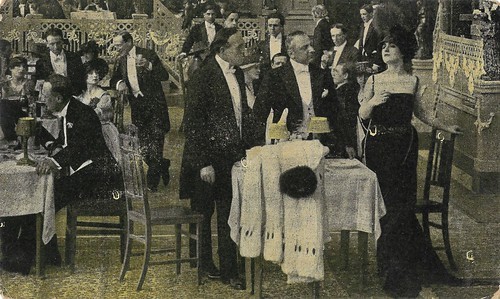
Spanish postcard by Amatller Marca Luna chocolate, Series 2a, no. 21. Photo: Caesar Film. Francesca Bertini in Il processo Clémenceau (Alfredo De Antoni, 1917).
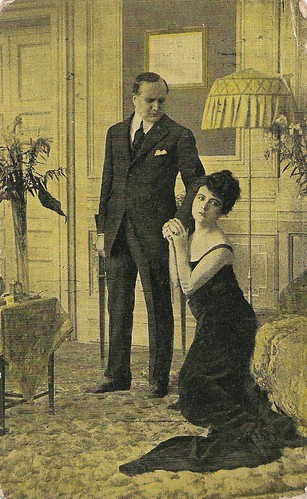
Spanish postcard by Amatller Marca Luna chocolate, Series 2a, no. 22. Photo: Caesar Film. Francesca Bertini and Gustavo Serena in Il processo Clémenceau (Alfredo De Antoni, 1917).
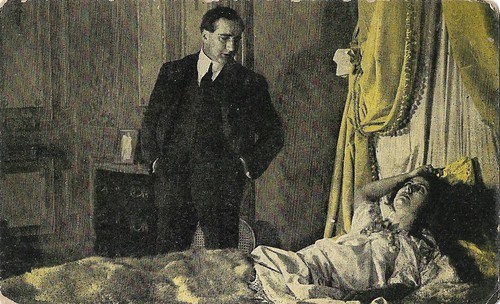
Spanish postcard by Amatller Marca Luna chocolate, Series 2a, no. 23. Photo: Caesar Film. Francesca Bertini and Gustavo Serena in Il processo Clémenceau (Alfredo De Antoni, 1917).
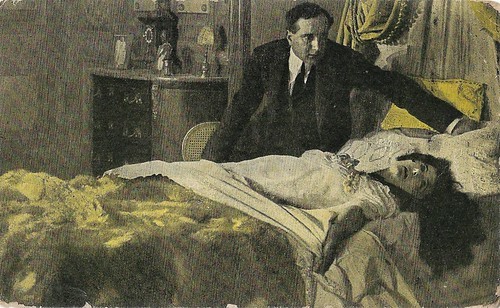
Spanish postcard by Amatller Marca Luna chocolate, Series 2a, no. 24. Photo: Caesar Film. Francesca Bertini and Gustavo Serena in Il processo Clémenceau (Alfredo De Antoni, 1917).
Sources: Vittorio Martinelli (Il cinema muto italiano 1917 - Italian), Ivo Blom (Film and Media Studies 7, 2013), Wikipedia and IMDb.

Spanish postcard by Amatller Marca Luna chocolate, Series 2a, no. 1. Photo: Caesar Film. A young Vittorio De Sica in Il processo Clémenceau (Alfredo De Antoni, 1917). In the film, this scene is mirrored. Young Pierre Clemenceau tells his mother he has won the first prize and may start working at the sculptor studio of the father of his friend Costantino.

Spanish postcard by Amatller Marca Luna chocolate, Series 2a, no. 6. Photo: Caesar Film. Francesca Bertini and Gustavo Serena in Il processo Clémenceau (Alfredo De Antoni, 1917).

Spanish postcard by Amatller Marca Luna chocolate, Series 2a, no. 7. Photo: Caesar Film. Francesca Bertini in Il processo Clémenceau (Alfredo De Antoni, 1917).

Spanish postcard by Amatller Marca Luna chocolate, Series 2a, no. 8. Photo: Caesar Film. Francesca Bertini and Gustavo Serena in Il processo Clémenceau (Alfredo De Antoni, 1917).

Spanish postcard by Amatller Marca Luna chocolate, Series 2a, no. 9. Photo: Caesar Film. Francesca Bertini in Il processo Clémenceau (Alfredo De Antoni, 1917).
Why he killed his wife
In Il processo Clémenceau/The Clemenceau Affair (Alfredo De Antoni, 1917), the sculptor Pierre Clemenceau ( Gustavo Serena ), imprisoned and waiting for his trial, writes why he killed his wife, played by diva Francesca Bertini .
As a young man of poor descent ( Vittorio De Sica ), he is fortunate to start training with the acclaimed sculptor Ritz, father of his school friend Costantino.
Years after, he has become a sculptor himself and meets the young impoverished Polish countess Iza Dobronowska ( Francesca Bertini ), who models for him for a bust. They fall in love and are betrothed, but Iza's scheming and gold-digging aunt Mathilde (Nella Montagna) has also awakened Iza's lust for money and luxury.
The aunt takes Iza away from Pierre to Poland, in order to get hold of their family patrimony. In Poland, Mathilde connects Iza with a young prince, Sergio ( Lido Manetti a.k.a. Arnold Kent), who indebts himself for the two women. His father finds out and takes action: he exiles his son to the Caucasus and denounces the two women, who lose everything.
Iza writes a letter of pardon to Pierre and asks him to take her away, which he does. He takes her to Paris and marries her. They also get a child. Mathilde hasn't given up and comes to Paris with Sergio, who has fled from the Caucasus. Iza is once more dazzled and cheated by their highlife and abandons Pierre a second time.
An additional complication is the middle-class morality of Pierre's mother which disgusts Iza. The mother dies of an attack before she can tell Pierre about his wife's adultery and behaviour. But when he finds Iza's bust at Sergio's place, he destroys the bust representing her and defies Sergio to a duel, killing him.
Pierre's best friend Costantino (played by director Alfredo De Antoni himself) meets Iza in a restaurant and is abhorred by her behaviour, but in the end, she knows she can seduce any man. Pierre stops working and retreats to Rome. When Pierre meets her time after, Iza is repenting and longs for her lost child. They have one last night of love, after which he kills her in a blind rage, unable to cope with her behaviour and not believing in her moral contrition. So the artist creates but also destroys both his artwork and the model.

Spanish postcard by Amatller Marca Luna chocolate, Series 2a, no. 10. Photo: Caesar Film. Francesca Bertini , Nella Montagna and Gustavo Serena in Il processo Clémenceau (Alfredo De Antoni, 1917).

Spanish postcard by Amatller Marca Luna chocolate, Series 2a, no. 11. Photo: Caesar Film. Francesca Bertini and Gustavo Serena in Il processo Clémenceau (Alfredo De Antoni, 1917).

Spanish postcard by Amatller Marca Luna chocolate, Series 2a, no. 13. Photo: Caesar Film. Lido Manetti and Francesca Bertini in Il processo Clémenceau (Alfredo De Antoni, 1917).

Spanish postcard by Amatller Marca Luna chocolate, Series 2a, no. 14. Photo: Caesar Film. Francesca Bertini in Il processo Clémenceau (Alfredo De Antoni, 1917).

Spanish postcard by Amatller Marca Luna chocolate, Series 2a, no. 16. Photo: Caesar Film. Francesca Bertini in Il processo Clémenceau (Alfredo De Antoni, 1917).
A massive audience
Il processo Clémenceau/The Clemenceau Affair (Alfredo De Antoni, 1917) was based on a play by Alexandre Dumas fils, L'affaire Clémenceau (1866), and scripted by director Alfredo De Antoni and Giuseppe Paolo Pacchierotti.
The cinematography was by Alberto Carta, and the sets were created by Alfredo Manzi. The film was produced by Caesar Film.
While the Roman press was extremely positive about the story and Bertini's interpretation, the Turinese press was more critical about the complicated storyline and the actors' performances but had to admit that the audience was so massive that on a Sunday, two weeks after the premiere, the armed forces had to assist when thousands could not get a place anymore.
A positive nitrate print of the film was found at the Filmoteca de la Generalitat de Valencia and restored by the Cineteca del Comune di Bologna. Clips from the film were used in the Dutch film Diva dolorosa (1999) by Peter Delpeut.
In 1993, Il processo Clémenceau/The Clemenceau Affair (Alfredo De Antoni, 1917) was restaurated by the Cineteca di Bologna. You can see the full film at YouTube.

Spanish postcard by Amatller Marca Luna chocolate, Series 2a, no. 17. Photo: Caesar Film. Francesca Bertini in Il processo Clémenceau (Alfredo De Antoni, 1917).

Spanish postcard by Amatller Marca Luna chocolate, Series 2a, no. 18. Photo: Caesar Film. Francesca Bertini in Il processo Clémenceau (Alfredo De Antoni, 1917).

Spanish postcard by Amatller Marca Luna chocolate, Series 2a, no. 19. Photo: Caesar Film. Alfredo de Antoni and Francesca Bertini in Il processo Clémenceau (Alfredo De Antoni, 1917).

Spanish postcard by Amatller Marca Luna chocolate, Series 2a, no. 20. Photo: Caesar Film. Francesca Bertini in Il processo Clémenceau (Alfredo De Antoni, 1917).

Spanish postcard by Amatller Marca Luna chocolate, Series 2a, no. 21. Photo: Caesar Film. Francesca Bertini in Il processo Clémenceau (Alfredo De Antoni, 1917).

Spanish postcard by Amatller Marca Luna chocolate, Series 2a, no. 22. Photo: Caesar Film. Francesca Bertini and Gustavo Serena in Il processo Clémenceau (Alfredo De Antoni, 1917).

Spanish postcard by Amatller Marca Luna chocolate, Series 2a, no. 23. Photo: Caesar Film. Francesca Bertini and Gustavo Serena in Il processo Clémenceau (Alfredo De Antoni, 1917).

Spanish postcard by Amatller Marca Luna chocolate, Series 2a, no. 24. Photo: Caesar Film. Francesca Bertini and Gustavo Serena in Il processo Clémenceau (Alfredo De Antoni, 1917).
Sources: Vittorio Martinelli (Il cinema muto italiano 1917 - Italian), Ivo Blom (Film and Media Studies 7, 2013), Wikipedia and IMDb.
Published on November 26, 2019 22:00
November 25, 2019
Frou-Frou (1918)
Italian diva Francesca Bertini played the title role in Frou-Frou (1918), adapted from a play by Henri Meilhac and Ludovic Halévy. The remarkable cards in this post Spanish collectors cards were published by Chocolat Imperiale, and the photos were made by Pinto in Rome for Caesar Film .
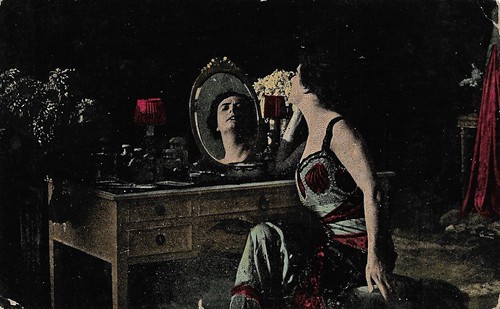
Spanish collectors card by Chocolat Imperiale, no. 1. Photo: Pinto, Roma / Caesar Film. Francesca Bertini in Frou-Frou (Alfredo De Antoni, 1918).
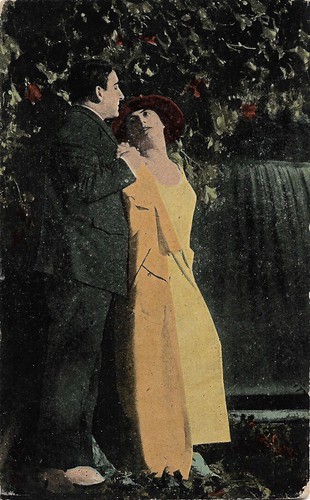
Spanish collectors card by Chocolat Imperiale, no. 2. Photo: Pinto, Roma / Caesar Film. Francesca Bertini and Guido Trento in Frou-Frou (Alfredo De Antoni, 1918).
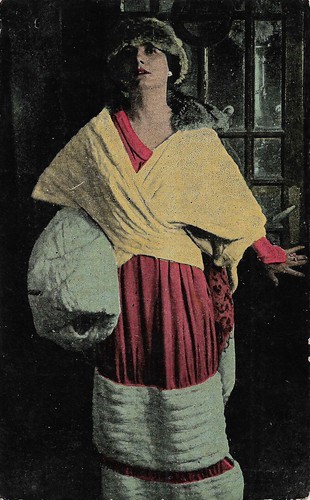
Spanish collectors card by Chocolat Imperiale', no. 3. Photo: Pinto, Roma / Caesar Film. Francesca Bertini in Frou-Frou (Alfredo De Antoni, 1918).
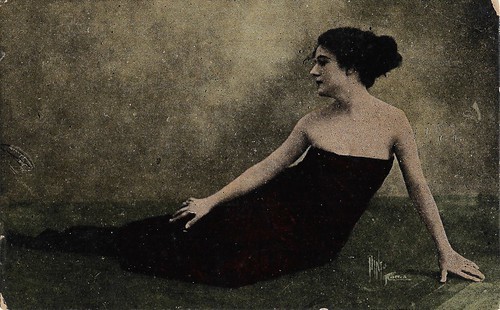
Spanish collectors card by Chocolat Imperiale', no. 4. Photo: Pinto, Roma / Caesar Film. Francesca Bertini in Frou-Frou (Alfredo De Antoni, 1918).
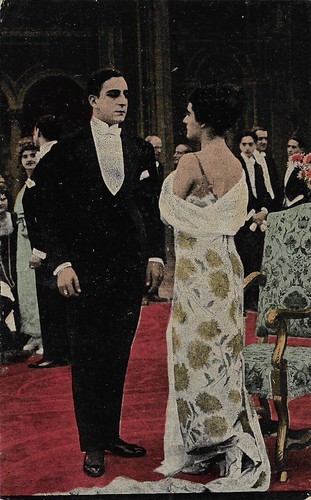
Spanish collectors card by Chocolat Imperiale', no. 5. Photo: Pinto, Roma / Caesar Film. Francesca Bertini and Guido Trento in Frou-Frou (Alfredo De Antoni, 1918).
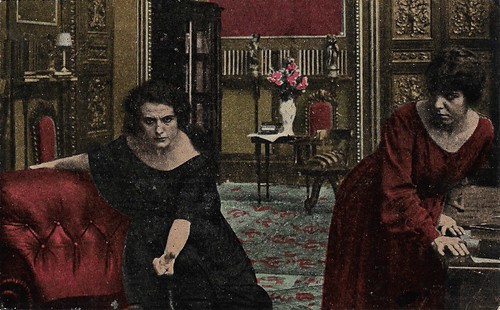
Spanish collectors card by Chocolat Imperiale', no. 6. Photo: Pinto, Roma / Caesar Film. Francesca Bertini and Cia Fornaroli in Frou-Frou (Alfredo De Antoni, 1918).
Serenely breathing her last breath in hr husband's arms
Francesca Bertini plays in Frou-Frou (Alfredo De Antoni, 1918) Gilberte 'Frou Frou' Sartorys, a beautiful but rather heedless young woman. She is bored by her quiet life with Count Henri Sartorys ( Gustavo Serena ), a brilliant but calm and phlegmatic diplomat. She is also indifferent to her little son Georges.
So she starts a flirt with a depraved aristocrat, Count Paul de Valréas (Guido Trento). Paul convinces Gilberte to bring her somber sister Louise (Cia Fornaroli) into the household, so she has more time for herself. Moreover, Louise is secretly in love with Henri. Louise quickly assumes the direction of Henri's home and innocently supplants Frou Frou in the eyes of her husband and child.
Sensing that her presence is no longer needed at the Sartorys estate, Frou Frou bitterly denounces Louise and then elopes with Paul to Venice. When the husband finds out about the adultery, he challenges the rival to a duel and kills him. He chases the supposedly faithless wife too.
One year after, she who once was rich and beautiful, is reduced to poverty and lies dying in a small bed in Venice. Louise finds her and summons Henri and Georges. She implores and receives the pardon of her husband, in whose arms she serenely breathes her last breath.
Frou-Frou premiered in Rome on 10 May 1918. The cinematography was by Alberto Carta and sets by Alfredo Manzi. In addition to Bertini, Serena, Fornaroli and Trento, other actors were Franco Gennaro (Gilberte's father), and Alfredo De Antoni, while we recognised also Olga Benetti on one of our cards.
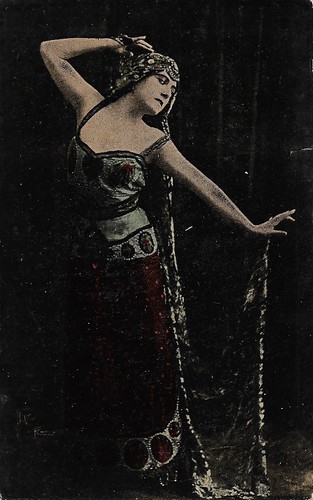
Spanish collectors card by Chocolat Imperiale, no. 7. Photo: Pinto, Roma / Caesar Film. Francesca Bertini in Frou-Frou (Alfredo De Antoni, 1918).
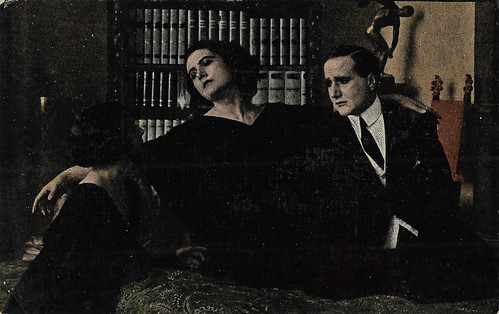
Spanish collectors card by Chocolat Imperiale', no. 8. Photo: Pinto, Roma / Caesar Film. Francesca Bertini and Gustavo Serena in Frou-Frou (Alfredo De Antoni, 1918).
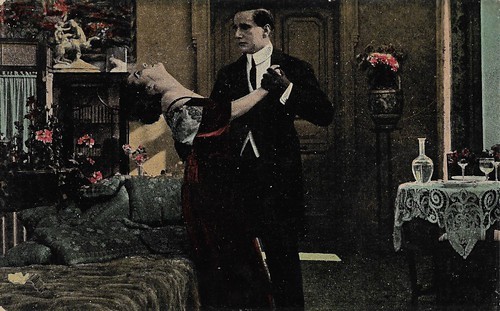
Spanish collectors card by Chocolat Imperiale, no. 9. Photo: Pinto, Roma / Caesar Film. Francesca Bertini and Gustavo Serena in Frou-Frou (Alfredo De Antoni, 1918).
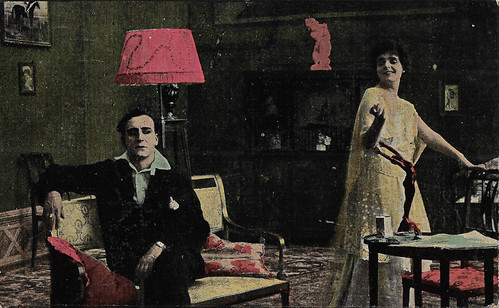
Spanish collectors card by Chocolat Imperiale no. 10. Photo: Pinto, Roma / Caesar Film. Guido Trento and Olga Benetti in Frou-Frou (Alfredo De Antoni, 1918).
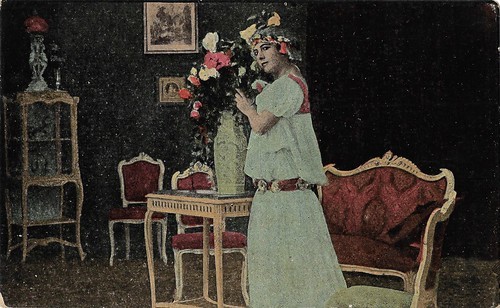
Spanish collectors card by Chocolat Imperiale, no. 11. Photo: Pinto, Roma / Caesar Film. Francesca Bertini in Frou-Frou (Alfredo De Antoni, 1918).
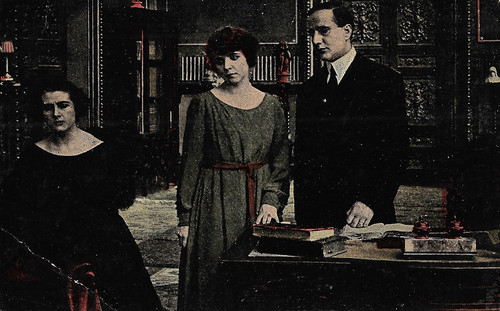
Spanish collectors card by Chocolat Imperiale, no. 12. Photo: Pinto, Roma / Caesar Film. Francesca Bertini , Cia Fornaroli and Gustavo Serena in Frou-Frou (Alfredo De Antoni, 1918).
An embodiment of the pain of her time
The Italian press was not very impressed by Frou-Frou (Alfredo De Antoni, 1918). Bertoldo wrote in the Turinese trade journal La vita cinematografica in 1919 that Bertini's beauty and elegance had suffocated any other artistic element, so the film looked more like a fashion show. "The actress goes around with the impassibility and certainty of a mannequin."
Instead, the French critic Louis Delluc, when raving about Bertini in his articles in the late 1910s and early 1920s, often mentioned this film too, in addition to La signora dalle camelie, Fedora, Tosca, and others.
Also, when the film was shown in Barcelona, a critic with the pseudonym Colombine wrote (cited at Sempre in penombra): "She is more than a woman an embodiment of the pain of her time because always the myth and the legend embodied the pain in figures of women. Bertini is a woman who suffers a lot, who suffers excessively, who falls under the weight of suffering. It touches us more because she suffers with a face so delicate, so soft, of such a dramatic dramatic profile, that pain is primed in its beauty.
Truly, Bertini's face knows how to reveal the most distinguished pain, with the purest features, and, contemplating it, she thinks with fear of the voluptuousness of the crowds who see her suffer as if falling apart under a rough caress that kisses her, tormenting her. It enjoys getting excited to see her faint, more beautiful in those lazy and languid expressions of pain for which she prepares so much, wearing black dresses, which become her suffering figure so well, and those dresses which sharpen her necklines; as if her necklines made suffering more seductive.
{...} She offers herself in her films such that it is as if she were offering herself multiplied, making an impossible effort, so that the film shows are celebrated with the amount of relief for the fate of the wounded, the widows and the orphans. One of these sessions, given in Rome, has had the interest of attending Bertini in person. The public has been able to verify the reality, see the relief and the life of the woman who is presented as something unreal, as an enigma to the near and distant couple.
After contemplating her in the darkness of the auditorium her rare duplicity, her unfolding, of seeing herself as alien to herself, she has been applauded deliriously. The newspapers say that Bertini "greeted with tears in the eyes" that audience that was moved, engaged in war, who came to the call of charity, and that perhaps did not applaud Bertini, but all the soul she had given to those other women who lived from her life, detached from her in the progression of the cinematograph."
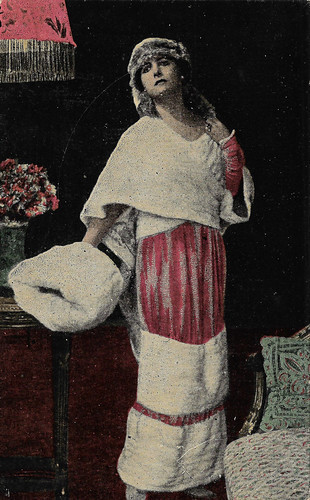
Spanish collectors card by Chocolat Imperiale', no. 13. Photo: Pinto, Roma / Caesar Film. Francesca Bertini in Frou-Frou (Alfredo De Antoni, 1918).
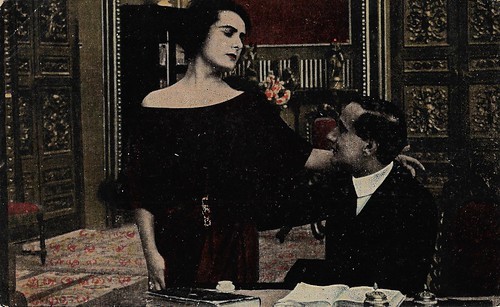
Spanish collectors card by Chocolat Imperiale', no. 14. Photo: Pinto, Roma / Caesar Film. Francesca Bertini and Gustavo Serena in Frou-Frou (Alfredo De Antoni, 1918).

Spanish collectors card by Chocolat Imperiale', no. 15. Photo: Pinto, Roma / Caesar Film. Francesca Bertini in Frou-Frou (Alfredo De Antoni, 1918).
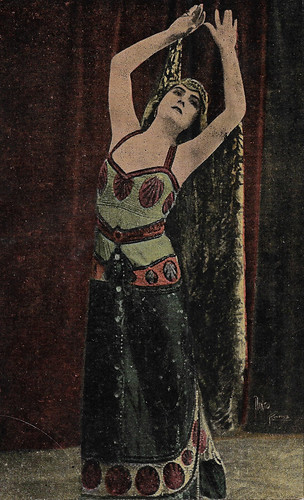
Spanish collectors card by Chocolat Imperiale', no. 16. Photo: Pinto, Roma / Caesar Film. Francesca Bertini in Frou-Frou (Alfredo De Antoni, 1918).
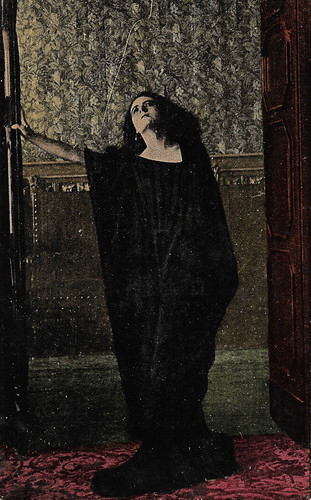
Spanish collectors card by Chocolat Imperiale', no. 17. Photo: Pinto, Roma / Caesar Film. Francesca Bertini in Frou-Frou (Alfredo De Antoni, 1918).
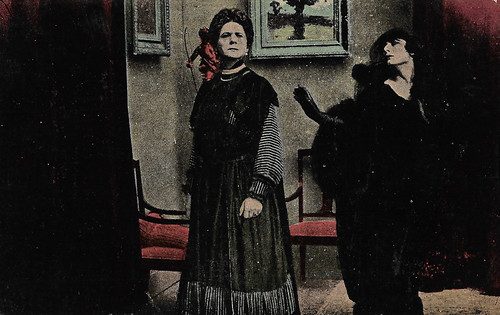
Spanish collectors card by Chocolat Imperiale', no. 18. Photo: Pinto, Roma / Caesar Film. Francesca Bertini in Frou-Frou (Alfredo De Antoni, 1918).
Sarah Bernhardt versus Eleonora Duse
The play Frou-Frou (1869) by Henri Meilhac and Ludovic Halévy was often adapted to film: in 1914, 1924, 1918 and 1938. Other films called Frou-Frou were not based on the play, such as editions of 1913 and 1955.
Before being adapted to the cinema, Frou-Frou had been an important play for both Sarah Bernhardt and Eleonora Duse . Theatre critic Richard Nathanson, who had seen the performances of Frou-Frou by both actresses, was convinced Duse was better than Bernhardt, because of her capabilities to interiorise.
On Bernhardt's performance, he wrote in his book 'Schauspieler und Theater im heutigen Italien' (1893): "The words came out as they can to adequately pronounce only one virtuoso of the scene, but the soul, the more inner human nature that wanted to manifest itself, that did not come out."
Instead, on Duse's performance of the crucial scene in which Frou-Frou settles accounts with her sister, he wrote: "The figure grew imposingly; glowing and burning sparks burst from her eyes; her chest rose and fell, as if she were working in a volcano, and therefore broke the torrent of speech from the lips - lips on which she had flinched - like lava that overwhelmed with herself everything, powerful, sudden, hitting mortally."
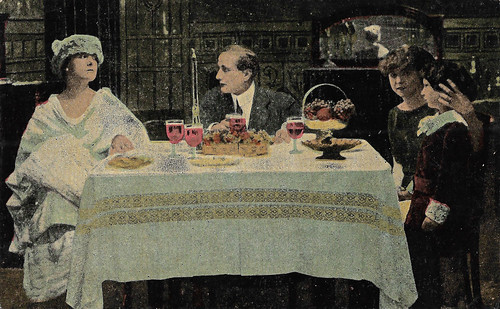
Spanish collectors card by Chocolat Imperiale', no. 19. Photo: Pinto, Roma / Caesar Film. Francesca Bertini , Cia Fornaroli and Gustavo Serena in Frou-Frou (Alfredo De Antoni, 1918).
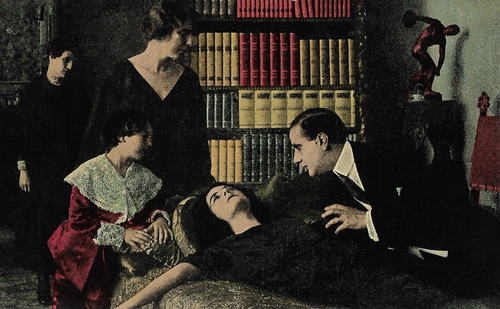
Spanish collectors card by Chocolat Imperiale', no. 20. Photo: Pinto, Roma / Caesar Film. Francesca Bertini , Cia Fornaroli and Gustavo Serena in Frou-Frou (Alfredo De Antoni, 1918).
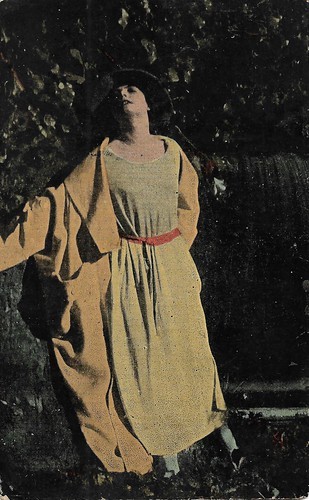
Spanish collectors card by Chocolat Imperiale', no. 21. Photo: Pinto, Roma / Caesar Film. Francesca Bertini in Frou-Frou (Alfredo De Antoni, 1918).
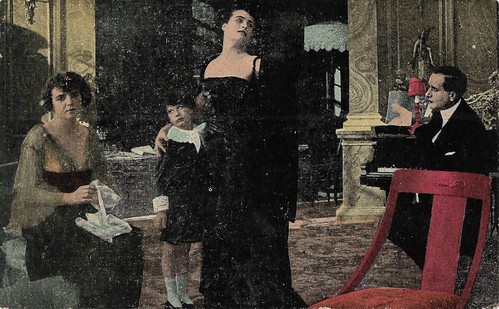
Spanish collectors card by Chocolat Imperiale', no. 22. Photo: Pinto, Roma / Caesar Film. Francesca Bertini >, Cia Fornaroli and Gustavo Serena in Frou-Frou (Alfredo De Antoni, 1918).
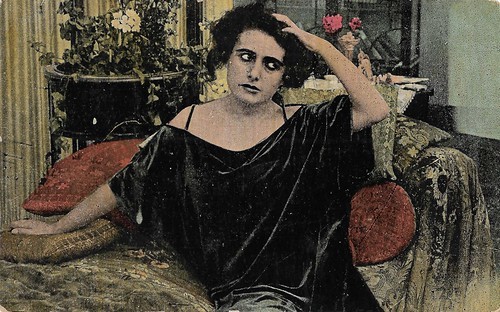
Spanish collectors card by Chocolat Imperiale', no. 23. Photo: Pinto, Roma / Caesar Film. Francesca Bertini in Frou-Frou (Alfredo De Antoni, 1918).
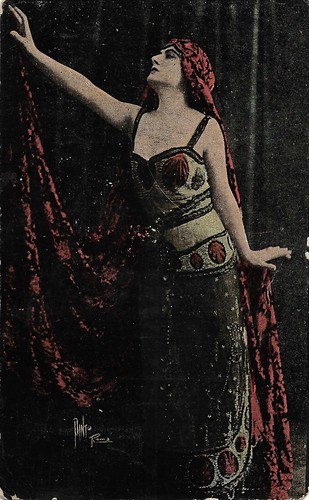
Spanish collectors card by Chocolat Imperiale', no. 24. Photo: Pinto, Roma / Caesar Film. Francesca Bertini in Frou-Frou (Alfredo De Antoni, 1918).
Sources: Sempre in penombra (Italian), Acting Archives Review (Italian), Wikipedia (Italian) and IMDb.

Spanish collectors card by Chocolat Imperiale, no. 1. Photo: Pinto, Roma / Caesar Film. Francesca Bertini in Frou-Frou (Alfredo De Antoni, 1918).

Spanish collectors card by Chocolat Imperiale, no. 2. Photo: Pinto, Roma / Caesar Film. Francesca Bertini and Guido Trento in Frou-Frou (Alfredo De Antoni, 1918).

Spanish collectors card by Chocolat Imperiale', no. 3. Photo: Pinto, Roma / Caesar Film. Francesca Bertini in Frou-Frou (Alfredo De Antoni, 1918).

Spanish collectors card by Chocolat Imperiale', no. 4. Photo: Pinto, Roma / Caesar Film. Francesca Bertini in Frou-Frou (Alfredo De Antoni, 1918).

Spanish collectors card by Chocolat Imperiale', no. 5. Photo: Pinto, Roma / Caesar Film. Francesca Bertini and Guido Trento in Frou-Frou (Alfredo De Antoni, 1918).

Spanish collectors card by Chocolat Imperiale', no. 6. Photo: Pinto, Roma / Caesar Film. Francesca Bertini and Cia Fornaroli in Frou-Frou (Alfredo De Antoni, 1918).
Serenely breathing her last breath in hr husband's arms
Francesca Bertini plays in Frou-Frou (Alfredo De Antoni, 1918) Gilberte 'Frou Frou' Sartorys, a beautiful but rather heedless young woman. She is bored by her quiet life with Count Henri Sartorys ( Gustavo Serena ), a brilliant but calm and phlegmatic diplomat. She is also indifferent to her little son Georges.
So she starts a flirt with a depraved aristocrat, Count Paul de Valréas (Guido Trento). Paul convinces Gilberte to bring her somber sister Louise (Cia Fornaroli) into the household, so she has more time for herself. Moreover, Louise is secretly in love with Henri. Louise quickly assumes the direction of Henri's home and innocently supplants Frou Frou in the eyes of her husband and child.
Sensing that her presence is no longer needed at the Sartorys estate, Frou Frou bitterly denounces Louise and then elopes with Paul to Venice. When the husband finds out about the adultery, he challenges the rival to a duel and kills him. He chases the supposedly faithless wife too.
One year after, she who once was rich and beautiful, is reduced to poverty and lies dying in a small bed in Venice. Louise finds her and summons Henri and Georges. She implores and receives the pardon of her husband, in whose arms she serenely breathes her last breath.
Frou-Frou premiered in Rome on 10 May 1918. The cinematography was by Alberto Carta and sets by Alfredo Manzi. In addition to Bertini, Serena, Fornaroli and Trento, other actors were Franco Gennaro (Gilberte's father), and Alfredo De Antoni, while we recognised also Olga Benetti on one of our cards.

Spanish collectors card by Chocolat Imperiale, no. 7. Photo: Pinto, Roma / Caesar Film. Francesca Bertini in Frou-Frou (Alfredo De Antoni, 1918).

Spanish collectors card by Chocolat Imperiale', no. 8. Photo: Pinto, Roma / Caesar Film. Francesca Bertini and Gustavo Serena in Frou-Frou (Alfredo De Antoni, 1918).

Spanish collectors card by Chocolat Imperiale, no. 9. Photo: Pinto, Roma / Caesar Film. Francesca Bertini and Gustavo Serena in Frou-Frou (Alfredo De Antoni, 1918).

Spanish collectors card by Chocolat Imperiale no. 10. Photo: Pinto, Roma / Caesar Film. Guido Trento and Olga Benetti in Frou-Frou (Alfredo De Antoni, 1918).

Spanish collectors card by Chocolat Imperiale, no. 11. Photo: Pinto, Roma / Caesar Film. Francesca Bertini in Frou-Frou (Alfredo De Antoni, 1918).

Spanish collectors card by Chocolat Imperiale, no. 12. Photo: Pinto, Roma / Caesar Film. Francesca Bertini , Cia Fornaroli and Gustavo Serena in Frou-Frou (Alfredo De Antoni, 1918).
An embodiment of the pain of her time
The Italian press was not very impressed by Frou-Frou (Alfredo De Antoni, 1918). Bertoldo wrote in the Turinese trade journal La vita cinematografica in 1919 that Bertini's beauty and elegance had suffocated any other artistic element, so the film looked more like a fashion show. "The actress goes around with the impassibility and certainty of a mannequin."
Instead, the French critic Louis Delluc, when raving about Bertini in his articles in the late 1910s and early 1920s, often mentioned this film too, in addition to La signora dalle camelie, Fedora, Tosca, and others.
Also, when the film was shown in Barcelona, a critic with the pseudonym Colombine wrote (cited at Sempre in penombra): "She is more than a woman an embodiment of the pain of her time because always the myth and the legend embodied the pain in figures of women. Bertini is a woman who suffers a lot, who suffers excessively, who falls under the weight of suffering. It touches us more because she suffers with a face so delicate, so soft, of such a dramatic dramatic profile, that pain is primed in its beauty.
Truly, Bertini's face knows how to reveal the most distinguished pain, with the purest features, and, contemplating it, she thinks with fear of the voluptuousness of the crowds who see her suffer as if falling apart under a rough caress that kisses her, tormenting her. It enjoys getting excited to see her faint, more beautiful in those lazy and languid expressions of pain for which she prepares so much, wearing black dresses, which become her suffering figure so well, and those dresses which sharpen her necklines; as if her necklines made suffering more seductive.
{...} She offers herself in her films such that it is as if she were offering herself multiplied, making an impossible effort, so that the film shows are celebrated with the amount of relief for the fate of the wounded, the widows and the orphans. One of these sessions, given in Rome, has had the interest of attending Bertini in person. The public has been able to verify the reality, see the relief and the life of the woman who is presented as something unreal, as an enigma to the near and distant couple.
After contemplating her in the darkness of the auditorium her rare duplicity, her unfolding, of seeing herself as alien to herself, she has been applauded deliriously. The newspapers say that Bertini "greeted with tears in the eyes" that audience that was moved, engaged in war, who came to the call of charity, and that perhaps did not applaud Bertini, but all the soul she had given to those other women who lived from her life, detached from her in the progression of the cinematograph."

Spanish collectors card by Chocolat Imperiale', no. 13. Photo: Pinto, Roma / Caesar Film. Francesca Bertini in Frou-Frou (Alfredo De Antoni, 1918).

Spanish collectors card by Chocolat Imperiale', no. 14. Photo: Pinto, Roma / Caesar Film. Francesca Bertini and Gustavo Serena in Frou-Frou (Alfredo De Antoni, 1918).

Spanish collectors card by Chocolat Imperiale', no. 15. Photo: Pinto, Roma / Caesar Film. Francesca Bertini in Frou-Frou (Alfredo De Antoni, 1918).

Spanish collectors card by Chocolat Imperiale', no. 16. Photo: Pinto, Roma / Caesar Film. Francesca Bertini in Frou-Frou (Alfredo De Antoni, 1918).

Spanish collectors card by Chocolat Imperiale', no. 17. Photo: Pinto, Roma / Caesar Film. Francesca Bertini in Frou-Frou (Alfredo De Antoni, 1918).

Spanish collectors card by Chocolat Imperiale', no. 18. Photo: Pinto, Roma / Caesar Film. Francesca Bertini in Frou-Frou (Alfredo De Antoni, 1918).
Sarah Bernhardt versus Eleonora Duse
The play Frou-Frou (1869) by Henri Meilhac and Ludovic Halévy was often adapted to film: in 1914, 1924, 1918 and 1938. Other films called Frou-Frou were not based on the play, such as editions of 1913 and 1955.
Before being adapted to the cinema, Frou-Frou had been an important play for both Sarah Bernhardt and Eleonora Duse . Theatre critic Richard Nathanson, who had seen the performances of Frou-Frou by both actresses, was convinced Duse was better than Bernhardt, because of her capabilities to interiorise.
On Bernhardt's performance, he wrote in his book 'Schauspieler und Theater im heutigen Italien' (1893): "The words came out as they can to adequately pronounce only one virtuoso of the scene, but the soul, the more inner human nature that wanted to manifest itself, that did not come out."
Instead, on Duse's performance of the crucial scene in which Frou-Frou settles accounts with her sister, he wrote: "The figure grew imposingly; glowing and burning sparks burst from her eyes; her chest rose and fell, as if she were working in a volcano, and therefore broke the torrent of speech from the lips - lips on which she had flinched - like lava that overwhelmed with herself everything, powerful, sudden, hitting mortally."

Spanish collectors card by Chocolat Imperiale', no. 19. Photo: Pinto, Roma / Caesar Film. Francesca Bertini , Cia Fornaroli and Gustavo Serena in Frou-Frou (Alfredo De Antoni, 1918).

Spanish collectors card by Chocolat Imperiale', no. 20. Photo: Pinto, Roma / Caesar Film. Francesca Bertini , Cia Fornaroli and Gustavo Serena in Frou-Frou (Alfredo De Antoni, 1918).

Spanish collectors card by Chocolat Imperiale', no. 21. Photo: Pinto, Roma / Caesar Film. Francesca Bertini in Frou-Frou (Alfredo De Antoni, 1918).

Spanish collectors card by Chocolat Imperiale', no. 22. Photo: Pinto, Roma / Caesar Film. Francesca Bertini >, Cia Fornaroli and Gustavo Serena in Frou-Frou (Alfredo De Antoni, 1918).

Spanish collectors card by Chocolat Imperiale', no. 23. Photo: Pinto, Roma / Caesar Film. Francesca Bertini in Frou-Frou (Alfredo De Antoni, 1918).

Spanish collectors card by Chocolat Imperiale', no. 24. Photo: Pinto, Roma / Caesar Film. Francesca Bertini in Frou-Frou (Alfredo De Antoni, 1918).
Sources: Sempre in penombra (Italian), Acting Archives Review (Italian), Wikipedia (Italian) and IMDb.
Published on November 25, 2019 22:00
November 24, 2019
Jorge Negrete
Mexican singer and actor Jorge Negrete (1911-1953) was for many years considered the number 1 entertainer in Latin America. More than 50 years after his death, he is still an icon in Mexico, Spain, and Latin America. His rendition of 'México Lindo y Querido' (Beautiful and Beloved México), his country’s unofficial anthem, is an evergreen. Typical is his manly, arrogant yet good-humoured singing and romantic image, dressed in Charro (cowboy) attire. 'El Charro Cantor' appeared in 44 films.
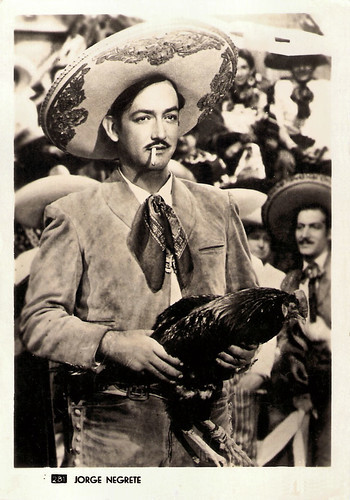
Spanish postcard, no. 281. Sent by mail in 1950.
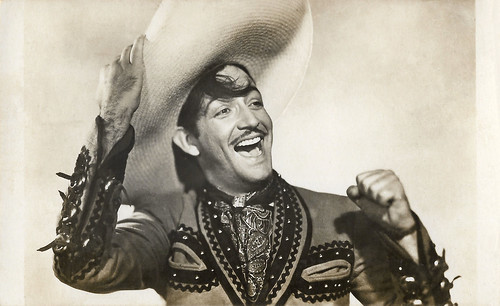
Spanish postcard by C.M.B., no. 120. Photo: Procines S.A.
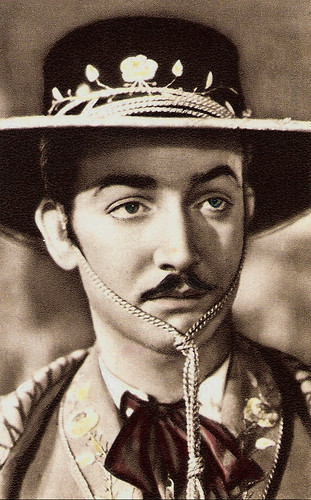
Spanish postcard, no. 24.
The Mexican Caballeros
Jorge Alberto Negrete Moreno was born in the city of Guanajuato in 1911. His parents were Emilia Moreno Anaya and David Negrete Fernández. He had two brothers and three sisters.
Their father was a Mexican Army Colonel who around 1920 quit his military career and moved with his family to Mexico City. There he found a job as a math teacher amongst others at the Humboldt German school, thus allowing Jorge and brother David to study there, learning German.
Because of misbehaviour, his father enrolled the 13 year old Jorge at the Heroico Colegio Militar (military academy of Mexico), where he learned English, French, and Italian. This was the place where also his fascination for music developed. His military training also forged him a gallant presence and a strong-willed character which would later benefit him in his acting career.
In 1937, Jorge was diagnosed with an hepatic dysfunction (hepatitis C) that did not prevent him from smoking all of his life. At 18, Jorge graduated with the rank of sub-lieutenant from El Colegio Militar.
He studied under José Pierson, a prestigious music professor and opera director, who became fascinated by Negrete's singing. Jorge had a fine, wide-ranged baritone voice. Pierson helped him develop his talent for opera and at the age of twenty Negrete began to sing for Radio XETR. In 1932 he recorded several operas using the stage-name Alberto Moreno.
In 1935 he debuted onstage with musical plays in Roberto Soto's company as a stage extra (figurante), working amongst others in 'Calles y más calles' at the Teatro Lírico. In 1936 Jorge Negrete signed with NBC Television for a TV program with Cuban and Mexican musicians.
He moved to New York and performed with a friend as The Mexican Caballeros. He also collaborated with band leader Xavier Cugat, and earned bookings at Latin clubs. The next year he made his first film appearance in the Warner Brothers short Cuban Nights.
He returned to Mexico in 1937 to act in his first feature film La Madrina Del Diablo/The Devil's Godmother (Ramón Peón, 1937) and because of the success of the film he was able to sign for several more films the next three years. During the shooting of his next film, La Valentina (Martín de Lucenay, 1938) he met dancer and actress Elisa Christy. They married in 1940, and moved for some time to New York where Jorge wrote Spanish versions to English songs for Southern Music.
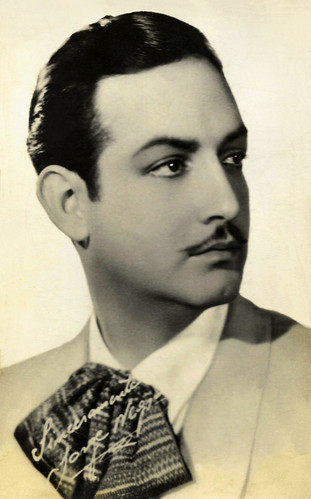
Spanish postcard by Sobe, no. 447. Caption: Sinceramente Jorge Negrete.
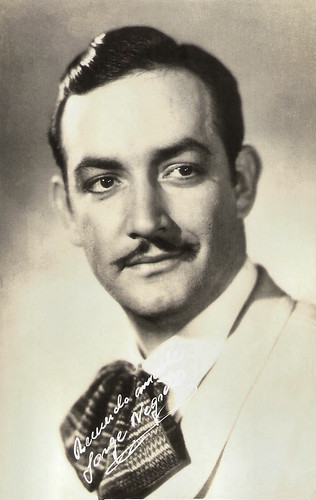
Spanish postcard. Sent by mail in 1950.
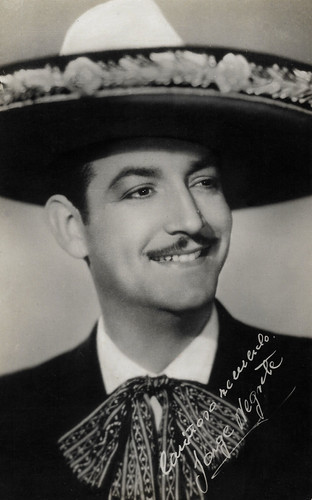
Spanish postcard by JDP, Valencia, no. 2081.
Comedias Rancheras
After working in Havana and Hollywood, Jorge Negrete was called to act in ¡Ay Jalisco, No Te Rajes!/Hey Jalisco, Don’t Back Down! (Joselito Rodríguez, 1941) which made him an international Latin star and helped formulate the Charro film genre. In these 'comedias rancheras' (ranch comedies) a folkloric world came alive, often including ancient songs that connected with the audience.
During filming of ¡Ay Jalisco, No Te Rajes!, he met Gloria Marín, and fell in love. He separated from Christy, who was pregnant with Negrete's daughter Diana, born the following year. Negrete and Gloria Marín lived together for 10 years and adopted a girl, Goyita.
He was offered the main role in El Peñón de las Ánimas/The Rock of Souls (Miguel Zacarías, 1943) and wanted Marín to be his co-star. In spite of his protests, newcomer María Félix became his star. She was equally arrogant as himself, so they had frequent quarrels on the set.
He had another resounding success with Me he de comer esa tuna/I have to eat that prickly pear (Miguel Zacarías, 1945). He complemented his film career by singing rancheras with the trio Los Tres Calaveras and touring Latin America, singing at concerts and making personal appearances. Negrete was also one of the founders of the Mexican Actors Association, succeeding Cantinflas as its chairman.
Negrete also starred in such Spanish films such as Jalisco canta en Sevilla/Jalisco sings in Seville (Fernando de Fuentes, 1949) opposite Carmen Sevilla , and Teatro Apolo/Apolo Theatre (Rafael Gil, 1950).
In 1952 he and María Félix met again shortly after he had left Gloria Marín, pride turned to love and they married that same year. They starred together in El rapto/The rapture (Emilio Fernández, 1954), his final film.
In 1953, when attending a boxing match in Los Angeles he suffered an acute gastroesophagical hemorrhage, from which he never regained conscience. These were complications of hepatic cirrhosis, the disease that he suffered since 1937. According to his wishes, his body was flown back to, and buried in, Mexico City. He was forty-two years old.
Negrete was the first to die of the 'Tres Gallos Mexicanos' (Three Mexican Roosters) as he, Pedro Infante and Javier Solís were called. Thousands of fans attended his funeral and followed the hearse to the cemetery, El Panteón Jardín.
On 5 December, the anniversary of his death, fans still pay tribute to 'El Charro Cantor' (the Singing Cowboy) at his tomb, and television stations stage marathons of his films. Jorge Negrete made 44 films. He had a daughter, Diana, and a stepson, actor Enrique Álvarez Félix. Jorge has five grandchildren, Déborah, Diana, Rafael, Liliana and Lorenzo. Rafael and Lorenzo are professional singers and use the Negrete last name for their artistic name.

Spanish postcard by P.M., Bilbao, no. 3018.
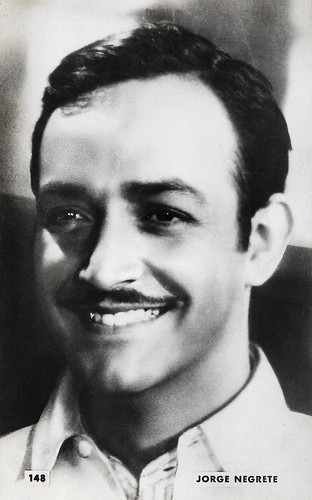
Spanish card, no. 148.
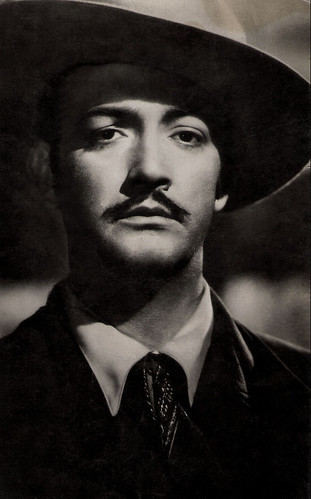
Spanish postcard by Sobes, no. 237.
Sources: Wikipedia and .

Spanish postcard, no. 281. Sent by mail in 1950.

Spanish postcard by C.M.B., no. 120. Photo: Procines S.A.

Spanish postcard, no. 24.
The Mexican Caballeros
Jorge Alberto Negrete Moreno was born in the city of Guanajuato in 1911. His parents were Emilia Moreno Anaya and David Negrete Fernández. He had two brothers and three sisters.
Their father was a Mexican Army Colonel who around 1920 quit his military career and moved with his family to Mexico City. There he found a job as a math teacher amongst others at the Humboldt German school, thus allowing Jorge and brother David to study there, learning German.
Because of misbehaviour, his father enrolled the 13 year old Jorge at the Heroico Colegio Militar (military academy of Mexico), where he learned English, French, and Italian. This was the place where also his fascination for music developed. His military training also forged him a gallant presence and a strong-willed character which would later benefit him in his acting career.
In 1937, Jorge was diagnosed with an hepatic dysfunction (hepatitis C) that did not prevent him from smoking all of his life. At 18, Jorge graduated with the rank of sub-lieutenant from El Colegio Militar.
He studied under José Pierson, a prestigious music professor and opera director, who became fascinated by Negrete's singing. Jorge had a fine, wide-ranged baritone voice. Pierson helped him develop his talent for opera and at the age of twenty Negrete began to sing for Radio XETR. In 1932 he recorded several operas using the stage-name Alberto Moreno.
In 1935 he debuted onstage with musical plays in Roberto Soto's company as a stage extra (figurante), working amongst others in 'Calles y más calles' at the Teatro Lírico. In 1936 Jorge Negrete signed with NBC Television for a TV program with Cuban and Mexican musicians.
He moved to New York and performed with a friend as The Mexican Caballeros. He also collaborated with band leader Xavier Cugat, and earned bookings at Latin clubs. The next year he made his first film appearance in the Warner Brothers short Cuban Nights.
He returned to Mexico in 1937 to act in his first feature film La Madrina Del Diablo/The Devil's Godmother (Ramón Peón, 1937) and because of the success of the film he was able to sign for several more films the next three years. During the shooting of his next film, La Valentina (Martín de Lucenay, 1938) he met dancer and actress Elisa Christy. They married in 1940, and moved for some time to New York where Jorge wrote Spanish versions to English songs for Southern Music.

Spanish postcard by Sobe, no. 447. Caption: Sinceramente Jorge Negrete.

Spanish postcard. Sent by mail in 1950.

Spanish postcard by JDP, Valencia, no. 2081.
Comedias Rancheras
After working in Havana and Hollywood, Jorge Negrete was called to act in ¡Ay Jalisco, No Te Rajes!/Hey Jalisco, Don’t Back Down! (Joselito Rodríguez, 1941) which made him an international Latin star and helped formulate the Charro film genre. In these 'comedias rancheras' (ranch comedies) a folkloric world came alive, often including ancient songs that connected with the audience.
During filming of ¡Ay Jalisco, No Te Rajes!, he met Gloria Marín, and fell in love. He separated from Christy, who was pregnant with Negrete's daughter Diana, born the following year. Negrete and Gloria Marín lived together for 10 years and adopted a girl, Goyita.
He was offered the main role in El Peñón de las Ánimas/The Rock of Souls (Miguel Zacarías, 1943) and wanted Marín to be his co-star. In spite of his protests, newcomer María Félix became his star. She was equally arrogant as himself, so they had frequent quarrels on the set.
He had another resounding success with Me he de comer esa tuna/I have to eat that prickly pear (Miguel Zacarías, 1945). He complemented his film career by singing rancheras with the trio Los Tres Calaveras and touring Latin America, singing at concerts and making personal appearances. Negrete was also one of the founders of the Mexican Actors Association, succeeding Cantinflas as its chairman.
Negrete also starred in such Spanish films such as Jalisco canta en Sevilla/Jalisco sings in Seville (Fernando de Fuentes, 1949) opposite Carmen Sevilla , and Teatro Apolo/Apolo Theatre (Rafael Gil, 1950).
In 1952 he and María Félix met again shortly after he had left Gloria Marín, pride turned to love and they married that same year. They starred together in El rapto/The rapture (Emilio Fernández, 1954), his final film.
In 1953, when attending a boxing match in Los Angeles he suffered an acute gastroesophagical hemorrhage, from which he never regained conscience. These were complications of hepatic cirrhosis, the disease that he suffered since 1937. According to his wishes, his body was flown back to, and buried in, Mexico City. He was forty-two years old.
Negrete was the first to die of the 'Tres Gallos Mexicanos' (Three Mexican Roosters) as he, Pedro Infante and Javier Solís were called. Thousands of fans attended his funeral and followed the hearse to the cemetery, El Panteón Jardín.
On 5 December, the anniversary of his death, fans still pay tribute to 'El Charro Cantor' (the Singing Cowboy) at his tomb, and television stations stage marathons of his films. Jorge Negrete made 44 films. He had a daughter, Diana, and a stepson, actor Enrique Álvarez Félix. Jorge has five grandchildren, Déborah, Diana, Rafael, Liliana and Lorenzo. Rafael and Lorenzo are professional singers and use the Negrete last name for their artistic name.

Spanish postcard by P.M., Bilbao, no. 3018.

Spanish card, no. 148.

Spanish postcard by Sobes, no. 237.
Sources: Wikipedia and .
Published on November 24, 2019 22:00
November 23, 2019
Ian McKellen
The career of English actor Ian McKellen (1939) spans genres ranging from Shakespearean and modern theatre to popular fantasy and Science Fiction. He became a stalwart of the Royal Shakespeare Company and the National Theatre of Great Britain. He achieved worldwide fame for his film roles, including the titular King in Richard III (1995), James Whale in Gods and Monsters (1998), Magneto in the X-Men films, and Gandalf in The Lord of the Rings and The Hobbit trilogies. For his work, McKellen received six Laurence Olivier Awards, a Tony Award, a Golden Globe Award, five Primetime Emmy Awards, four BAFTAs, and many other awards. He has been openly gay since 1988, and continues to be a champion for the LGBT movement.
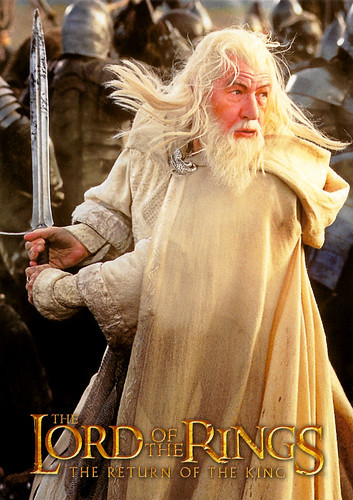
British postcard by GB Posters, Sheffield, no. PC0700. Photo: New Line Productions. Ian McKellen as Gandalf in The Lord of the Rings - The Return of the King (Peter Jackson, 2003).

British postcard. Photo: Ian McKellen as Magneto in X-Men - The Last Stand (Bryan Singer, 2006).
An early fascination with the theatre
Ian Murray McKellen was born in 1939 in Burnley, Lancashire. He was the son of Margery Lois (née Sutcliffe) and Denis Murray McKellen. He had a sister, Jean, five years his senior. McKellen's father was a civil engineer and lay preacher. His home environment was strongly Christian, but non-orthodox. When he was 12, his mother died of breast cancer; his father died when he was 24.
McKellen's acting career started at Bolton Little Theatre, of which he is now the patron. An early fascination with the theatre was encouraged by his parents, who took him on a family outing to 'Peter Pan' at the Opera House in Manchester when he was three. When he was nine, his main Christmas present was a fold-away wood and bakelite Victorian theatre from Pollocks Toy Theatres, with cardboard scenery and wires to push on the cut-outs of 'Cinderella' and of Laurence Olivier 's 'Hamlet'. His sister took him to his first Shakespeare play, 'Twelfth Night', by the amateurs of Wigan's Little Theatre.
In 1958, McKellen, at the age of 18, won a scholarship to St Catharine's College, Cambridge, where he read English literature. While at Cambridge, McKellen was a member of the Marlowe Society, where he appeared in 23 plays over the course of 3 years. He already gave performances that have since become legendary such as his Justice Shallow in 'Henry IV' alongside Trevor Nunn and Derek Jacobi in 1959. During this period McKellen was directed by Peter Hall, John Barton and Dadie Rylands, who had a huge impact on McKellen's future career.
He made his first professional appearance in 1961 as Roper in 'A Man for All Seasons'. After four years in regional repertory theatres he made his first West End appearance in 'A Scent of Flowers'. It was a success. In 1965 he was a member of Laurence Olivier 's National Theatre Company at the Old Vic.
With the Prospect Theatre Company, McKellen made his breakthrough performances of 'Richard II' and Marlowe's 'Edward II'. In the 1970s and 1980s, McKellen became a well-known figure in British theatre, performing frequently at the Royal Shakespeare Company and the Royal National Theatre, where he played several leading Shakespearean roles, including the title role in 'Macbeth', and Iago in 'Othello', in award-winning productions directed by Trevor Nunn. Both productions were adapted into television films, also directed by Nunn.
In 2007 he returned to the Royal Shakespeare Company, in productions of 'King Lear' and 'The Seagull', both again directed by Trevor Nunn. In 2009 he appeared in a very popular revival of 'Waiting for Godot', directed by Sean Mathias, and playing opposite Patrick Stewart .
In late August 2012, he took part in the opening ceremony of the London Paralympics, portraying Prospero from 'The Tempest'. In October 2017, McKellen played King Lear at Chichester Festival Theatre, a role which he said was likely to be his "last big Shakespearean part". He performed the play at the Duke of York's Theatre in London's West End during the summer of 2018.
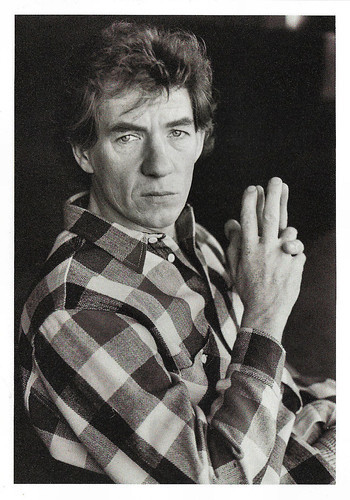
British postcard by Royal National Theatre (NT), no. NT 16. Photo: Jane Bown.

British postcard by Memory Card, no. 672. Photo: Ian McKellen as Magneto in X-Men (Bryan Singer, 2000).
Gods and Monsters
Ian McKellen had taken film roles throughout his career — beginning with his role of George Matthews in A Touch of Love (Waris Hussein, 1969) starring Sandy Dennis, and his first leading role was as D. H. Lawrence in Priest of Love (Christopher Miles, 1980).
McKellen played war minister John Profumo involved in a scandalous affair with an exotic dancer in Scandal (Michael Caton-Jones, 1989).
In the 1990s he became more widely recognised after several roles in Hollywood films. In 1993, he had a supporting role as a South African tycoon in the critically acclaimed Six Degrees of Separation (Fred Schepisi, 1993), with Stockard Channing, Donald Sutherland, and Will Smith.
In the same year, he appeared in the TV miniseries Tales of the City (Alastair Reid, 1993), based on the novel by his friend Armistead Maupin, and the film Last Action Hero (John McTiernan, 1993), in which he briefly played Death opposite Arnold Schwarzenegger . McKellen also appeared in the TV film And the Band Played On (Roger Spottiswoode, 1993) about the discovery of the AIDS virus for which he was nominated for an Emmy Award.
He played the title role in Richard III (Richard Loncraine, 1995) with Annette Bening and Robert Downey Jr., which transported the setting into an alternative 1930s in which England is ruled by fascists. The film which McKellen co-produced and co-wrote, was a critical success. His performance in the title role garnered BAFTA and Golden Globe nominations for Best Actor and won the European Film Award for Best Actor. His screenplay was nominated for the BAFTA Award for Best Adapted Screenplay.
He also appeared in the modestly acclaimed film Apt Pupil (1998), which was directed by Bryan Singer and based on a story by Stephen King. McKellen portrayed a fugitive Nazi officer living under a false name in the US who is befriended by a curious teenager (Brad Renfro) who threatens to expose him unless he tells his story in detail.
McKellen was subsequently nominated for the Oscar for Best Actor for his role in Gods and Monsters (Bill Condon, 1998), wherein he played of Frankenstein (1931) director James Whale.
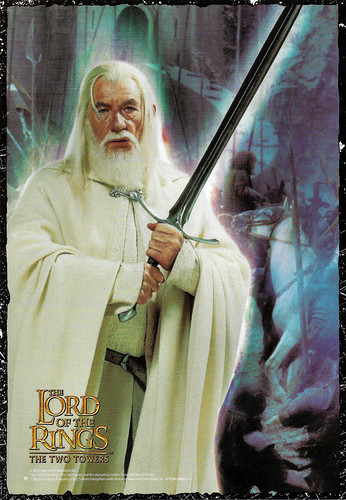
French postcard by Sonis, no. C. 1370. Photo: New Line Productions. Ian McKellen as Gandalf in The Lord of the Rings - The Two Towers (Peter Jackson, 2002).
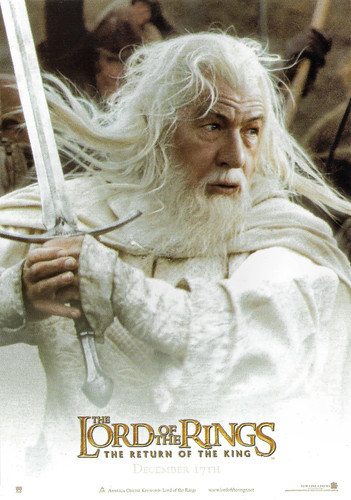
French postcard by Sonis, no. C. 1452. Photo: New Line Productions. Ian McKellen as Gandalf in The Lord of the Rings - The Return of the King (Peter Jackson, 2003).
Gandalf and Magneto
Ian McKellen was cast, again under the direction of Bryan Singer, to play the comic book supervillain Magneto in X-Men (2000) and its sequels X2: X-Men United (2003) and X-Men: The Last Stand (2006). He later made a short appearance as an older Magneto in X-Men: Days of Future Past (2014), sharing the role with Michael Fassbender, who played a younger version of the character in X-Men: First Class (2011).
While filming the first X-Men film in 1999, McKellen was cast as the wizard Gandalf in Peter Jackson's three-film adaptation of The Lord of the Rings: The Fellowship of the Ring (2001), The Two Towers (2002), and The Return of the King (2003). He was nominated for the Academy Award for Best Supporting Actor for his role. He provided the voice of Gandalf for several video game adaptations of the Lord of the Rings films, then reprised the role on screen in Jackson's film adaptation of The Hobbit, which was released in three parts from 2012 to 2014.
He also appeared as Sir Leigh Teabing in The Da Vinci Code (Ron Howard, 2006) opposite Tom Hanks and Audrey Tautou. McKellen portrayed Sherlock Holmes in Holmes (Bill Condon, 2017), and Cogsworth in the live-action adaptation of Disney's Beauty and the Beast (Bill Condon, 2017), starring Emma Watson.
Also in 2017, McKellen appeared in the documentary McKellen: Playing the Part (Joe Stephenson, 2017), which explores McKellen's life and career as an actor. McKellen's first partner was Brian Taylor, a history teacher from Bolton. Their relationship lasted from 1964 till 1972. In 1978 he met his second partner, actor-director Sean Mathias. This relationship lasted until 1988.
The couple worked later together on the film Bent (Sean Mathias, 1997) as well as in several stage productions. In 1988, McKellen came out to the general public on BBC Radio. The controversial Section 28 of the Local Government Bill was then under consideration in the British Parliament. McKellen became active in fighting the proposed law, and, during a BBC Radio 3 programme where he debated Section 28 with the conservative journalist Peregrine Worsthorne, declared himself gay. Section 28 was, however, enacted and remained on the statute books until 2000 in Scotland and 2003 in England and Wales.
McKellen has continued to be very active in LGBT rights efforts. Ian McKellen was knighted by Queen Elizabeth II in 1990 for his efforts in the arts. Ian Mc Kellen stays active for the cameras. This year, he can be seen in Bill Condon's The Good Liar (2019) opposite Helen Mirren, and as Gus, the theatre cat in Cats (Tom Hooper, 2019).
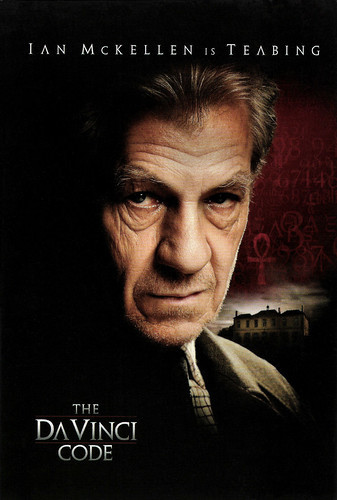
British postcard by Pacificmeg.com. Photo: Columbia Pictures / Sony Pictures. Ian McKellen as Sir Leigh Teabing in The Da Vinci Code (Ron Howard, 2006). This postcard was published for the VCD & DVD release in 2006.
Sources: Wikipedia and .

British postcard by GB Posters, Sheffield, no. PC0700. Photo: New Line Productions. Ian McKellen as Gandalf in The Lord of the Rings - The Return of the King (Peter Jackson, 2003).

British postcard. Photo: Ian McKellen as Magneto in X-Men - The Last Stand (Bryan Singer, 2006).
An early fascination with the theatre
Ian Murray McKellen was born in 1939 in Burnley, Lancashire. He was the son of Margery Lois (née Sutcliffe) and Denis Murray McKellen. He had a sister, Jean, five years his senior. McKellen's father was a civil engineer and lay preacher. His home environment was strongly Christian, but non-orthodox. When he was 12, his mother died of breast cancer; his father died when he was 24.
McKellen's acting career started at Bolton Little Theatre, of which he is now the patron. An early fascination with the theatre was encouraged by his parents, who took him on a family outing to 'Peter Pan' at the Opera House in Manchester when he was three. When he was nine, his main Christmas present was a fold-away wood and bakelite Victorian theatre from Pollocks Toy Theatres, with cardboard scenery and wires to push on the cut-outs of 'Cinderella' and of Laurence Olivier 's 'Hamlet'. His sister took him to his first Shakespeare play, 'Twelfth Night', by the amateurs of Wigan's Little Theatre.
In 1958, McKellen, at the age of 18, won a scholarship to St Catharine's College, Cambridge, where he read English literature. While at Cambridge, McKellen was a member of the Marlowe Society, where he appeared in 23 plays over the course of 3 years. He already gave performances that have since become legendary such as his Justice Shallow in 'Henry IV' alongside Trevor Nunn and Derek Jacobi in 1959. During this period McKellen was directed by Peter Hall, John Barton and Dadie Rylands, who had a huge impact on McKellen's future career.
He made his first professional appearance in 1961 as Roper in 'A Man for All Seasons'. After four years in regional repertory theatres he made his first West End appearance in 'A Scent of Flowers'. It was a success. In 1965 he was a member of Laurence Olivier 's National Theatre Company at the Old Vic.
With the Prospect Theatre Company, McKellen made his breakthrough performances of 'Richard II' and Marlowe's 'Edward II'. In the 1970s and 1980s, McKellen became a well-known figure in British theatre, performing frequently at the Royal Shakespeare Company and the Royal National Theatre, where he played several leading Shakespearean roles, including the title role in 'Macbeth', and Iago in 'Othello', in award-winning productions directed by Trevor Nunn. Both productions were adapted into television films, also directed by Nunn.
In 2007 he returned to the Royal Shakespeare Company, in productions of 'King Lear' and 'The Seagull', both again directed by Trevor Nunn. In 2009 he appeared in a very popular revival of 'Waiting for Godot', directed by Sean Mathias, and playing opposite Patrick Stewart .
In late August 2012, he took part in the opening ceremony of the London Paralympics, portraying Prospero from 'The Tempest'. In October 2017, McKellen played King Lear at Chichester Festival Theatre, a role which he said was likely to be his "last big Shakespearean part". He performed the play at the Duke of York's Theatre in London's West End during the summer of 2018.

British postcard by Royal National Theatre (NT), no. NT 16. Photo: Jane Bown.

British postcard by Memory Card, no. 672. Photo: Ian McKellen as Magneto in X-Men (Bryan Singer, 2000).
Gods and Monsters
Ian McKellen had taken film roles throughout his career — beginning with his role of George Matthews in A Touch of Love (Waris Hussein, 1969) starring Sandy Dennis, and his first leading role was as D. H. Lawrence in Priest of Love (Christopher Miles, 1980).
McKellen played war minister John Profumo involved in a scandalous affair with an exotic dancer in Scandal (Michael Caton-Jones, 1989).
In the 1990s he became more widely recognised after several roles in Hollywood films. In 1993, he had a supporting role as a South African tycoon in the critically acclaimed Six Degrees of Separation (Fred Schepisi, 1993), with Stockard Channing, Donald Sutherland, and Will Smith.
In the same year, he appeared in the TV miniseries Tales of the City (Alastair Reid, 1993), based on the novel by his friend Armistead Maupin, and the film Last Action Hero (John McTiernan, 1993), in which he briefly played Death opposite Arnold Schwarzenegger . McKellen also appeared in the TV film And the Band Played On (Roger Spottiswoode, 1993) about the discovery of the AIDS virus for which he was nominated for an Emmy Award.
He played the title role in Richard III (Richard Loncraine, 1995) with Annette Bening and Robert Downey Jr., which transported the setting into an alternative 1930s in which England is ruled by fascists. The film which McKellen co-produced and co-wrote, was a critical success. His performance in the title role garnered BAFTA and Golden Globe nominations for Best Actor and won the European Film Award for Best Actor. His screenplay was nominated for the BAFTA Award for Best Adapted Screenplay.
He also appeared in the modestly acclaimed film Apt Pupil (1998), which was directed by Bryan Singer and based on a story by Stephen King. McKellen portrayed a fugitive Nazi officer living under a false name in the US who is befriended by a curious teenager (Brad Renfro) who threatens to expose him unless he tells his story in detail.
McKellen was subsequently nominated for the Oscar for Best Actor for his role in Gods and Monsters (Bill Condon, 1998), wherein he played of Frankenstein (1931) director James Whale.

French postcard by Sonis, no. C. 1370. Photo: New Line Productions. Ian McKellen as Gandalf in The Lord of the Rings - The Two Towers (Peter Jackson, 2002).

French postcard by Sonis, no. C. 1452. Photo: New Line Productions. Ian McKellen as Gandalf in The Lord of the Rings - The Return of the King (Peter Jackson, 2003).
Gandalf and Magneto
Ian McKellen was cast, again under the direction of Bryan Singer, to play the comic book supervillain Magneto in X-Men (2000) and its sequels X2: X-Men United (2003) and X-Men: The Last Stand (2006). He later made a short appearance as an older Magneto in X-Men: Days of Future Past (2014), sharing the role with Michael Fassbender, who played a younger version of the character in X-Men: First Class (2011).
While filming the first X-Men film in 1999, McKellen was cast as the wizard Gandalf in Peter Jackson's three-film adaptation of The Lord of the Rings: The Fellowship of the Ring (2001), The Two Towers (2002), and The Return of the King (2003). He was nominated for the Academy Award for Best Supporting Actor for his role. He provided the voice of Gandalf for several video game adaptations of the Lord of the Rings films, then reprised the role on screen in Jackson's film adaptation of The Hobbit, which was released in three parts from 2012 to 2014.
He also appeared as Sir Leigh Teabing in The Da Vinci Code (Ron Howard, 2006) opposite Tom Hanks and Audrey Tautou. McKellen portrayed Sherlock Holmes in Holmes (Bill Condon, 2017), and Cogsworth in the live-action adaptation of Disney's Beauty and the Beast (Bill Condon, 2017), starring Emma Watson.
Also in 2017, McKellen appeared in the documentary McKellen: Playing the Part (Joe Stephenson, 2017), which explores McKellen's life and career as an actor. McKellen's first partner was Brian Taylor, a history teacher from Bolton. Their relationship lasted from 1964 till 1972. In 1978 he met his second partner, actor-director Sean Mathias. This relationship lasted until 1988.
The couple worked later together on the film Bent (Sean Mathias, 1997) as well as in several stage productions. In 1988, McKellen came out to the general public on BBC Radio. The controversial Section 28 of the Local Government Bill was then under consideration in the British Parliament. McKellen became active in fighting the proposed law, and, during a BBC Radio 3 programme where he debated Section 28 with the conservative journalist Peregrine Worsthorne, declared himself gay. Section 28 was, however, enacted and remained on the statute books until 2000 in Scotland and 2003 in England and Wales.
McKellen has continued to be very active in LGBT rights efforts. Ian McKellen was knighted by Queen Elizabeth II in 1990 for his efforts in the arts. Ian Mc Kellen stays active for the cameras. This year, he can be seen in Bill Condon's The Good Liar (2019) opposite Helen Mirren, and as Gus, the theatre cat in Cats (Tom Hooper, 2019).

British postcard by Pacificmeg.com. Photo: Columbia Pictures / Sony Pictures. Ian McKellen as Sir Leigh Teabing in The Da Vinci Code (Ron Howard, 2006). This postcard was published for the VCD & DVD release in 2006.
Sources: Wikipedia and .
Published on November 23, 2019 22:00
Paul van Yperen's Blog
- Paul van Yperen's profile
- 13 followers
Paul van Yperen isn't a Goodreads Author
(yet),
but they
do have a blog,
so here are some recent posts imported from
their feed.



